Management Strategies for Recovery of Atlantic Cod Stocks - Eastern Scotian Shelf (4VsW) Sydney Bight (4Vn May-October)
September 2005
Table of Contents
Executive Summary
Atlantic cod stocks on the eastern Scotian Shelf and in Sydney Bight are components of what COSEWIC has called the Maritimes population. They share the status "of special concern" assigned by COSEWIC to the Maritimes population as a whole. Cod in the management units 4VsW (eastern Scotian Shelf) and 4Vn May-October. (Sydney Bight) are at their lowest abundance on record, they have a restricted distribution and exhibit poor growth and condition, early maturation and poor recruitment. Mortality is very high despite moratoria on directed fisheries. There are no indications of improvement.
There are a variety of hypotheses as to why these cod stocks have not recovered despite the cessation of directed fishing in 1993 and the return of oceanographic conditions closer to long-term averages after a severe cold spell in the late 1980s – early 1990s. Coincident changes in the abundance and population parameters of many other species indicate that there has been a major perturbation of the ecosystem as a whole. It does not appear that incidental catches in other fisheries are an important source of cod mortality but there is substantial mortality of juvenile cod due to predation, particularly by grey seals. The high mortality of adult cod may be due to poor fish condition caused primary by a reduced supply of food, but a high sealworm infection rate also could be contributing to mortality. Poor recruitment could be explained by several factors; loss of spawning components and low abundance of spawners generally have reduced spawning potential, and predation of cod eggs and larvae by herring and mackerel may have increased as the populations of these species increased. It is possible also that change in ocean current patterns has reduced egg and larval survival, or that a reduction in suitable benthic habitat has reduced survival of juvenile cod.
The intention of this document is to identify what it is feasible to do to prevent further declines in cod abundance and indeed to encourage increases to historical levels. It is necessary to recognize that achievement of such an objective may not be possible, however, as oceanographic and ecosystem conditions may not allow for improvements in cod productivity for an indefinite period. However, some actions have been identified, in addition to those already in the present groundfish management plan, which merit evaluation. Some of these strategies could cause a reduction in cod mortality directly; others will contribute to effective control of mortality should there be some recovery in future. They are, in order of priority:
- develop a precautionary management decision framework so that there will be pre-agreement on the appropriate management responses to any apparent change in cod stock status
- evaluate the costs and benefits of reducing grey seal abundance once the results of new scientific analyses on cod predation mortality are available
- discontinue commercial index fisheries as these are not contributing to stock status evaluation
- review at-sea observer program coverage in 4VW invertebrate as well as groundfish fisheries to establish whether it is adequate to document cod bycatches and to detect major changes in bycatch rates
- enhance shared stewardship by exploring ways that industry information gathering and self-policing initiatives can be funded under SARA-related programs
- codify cod spawning locations and migration corridors into regulatory procedures for seismic surveying
- protect habitat of juvenile cod by limiting disturbance of bottom areas that are rich in vertical structure
Introduction
Atlantic cod in the southern Gulf of St. Lawrence and on the Scotian Shelf as far as the Gulf of Maine have been referred to as the "Maritimes population" by the Committee on the Status of Endangered Wildlife in Canada (COSEWIC). The Committee assigned a status of Special ConcernFootnote 1 to this population in May 2003 (COSEWIC, 2003). COSEWIC's rationale for this designation was as follows:
"Cod in the Southern Gulf of St. Lawrence, across the Scotian Shelf and into the Gulf of Maine comprise a heterogeneous assemblage of stocks that are at low levels of abundance as a group. These levels are not unprecedented for the cod in the Southern Gulf, Southwest Scotian Shelf, Bay of Fundy and George's Bank, but those on the Eastern Scotian Shelf are at historic lows and have continued to decline in the absence of directed fishing. Overall, cod in the entire region have declined 14% in the past 30 years, and have demonstrated a sensitivity to human activities. Threats to persistence include directed fishing, bycatch in other fisheries, natural predation, and natural and fishing-induced changes to the ecosystem."
This Maritimes population of COSEWIC encompasses the cod in five areas that have been used since the early 1970s for fishery management purposes. These management areas are defined, based on Northwest Atlantic Fisheries Organization (NAFO) statistical Divisions and Subdivisions, as 4T-Vn (November-April) (Southern Gulf of St. Lawrence), 4Vn (May-October) (Sydney Bight), 4VsW (Eastern Scotian Shelf), 4X (Southwestern Nova Scotia) and 5Zc (Canadian part of Georges Bank).
A Canada / Maritimes Provinces Action Team for Long-Term Cod Recovery was established in November 2003 with a mandate to prepare and implement recovery strategies for Atlantic cod in the waters off the Maritimes, i.e. off the Provinces of New Brunswick, Prince Edward Island and Nova Scotia. This is one of three such regional teams, others having been established for Newfoundland-Labrador and Laurentian cod populations. The work of these Action Teams will contribute to the decision by DFO on whether the various cod stocks in Canadian waters will be listed in Schedule I of the Species at Risk Act (SARA). Footnote 2
The present document is a contribution to the Canada / Maritimes Provinces Action Team by the DFO Scotia-Fundy Sector, Maritimes Region. It provides a basis for a management plan specifically for cod stocks on the eastern Scotian Shelf (4VsW) and in Sydney Bight (4Vn (May-October)) that addresses the issues associated with recovery. (These management areas are illustrated in Fig. 1.) The need for a special recovery plan stems from the fact that, although there has been a moratorium on fishing for these stocks from 1993, there are no signs yet of improvement in stock status. Indeed, at least in 4VsW, stock abundance continues to decline. There is a need to determine whether more can be done now and to prepare for the eventuality that cod stocks show signs of recovery.
These cod stocks have been managed by DFO under a series of annual Atlantic zonal groundfish management plans, first instituted at the time of extension of fisheries jurisdiction in 1977, and, from 2000, under Scotia-Fundy Sector groundfish management plans. A multi-year plan is currently in effect (DFO, 2002b). The present document addresses how current management measures can be augmented for the specific purpose of enhancing the prospects for recovery of these two cod stocks. Should it transpire that the Maritimes population is listed as being "of special concern" in Schedule 1 of the SARA, production of such a management plan within three years would be a requirement.
The following report gives a history of the fisheries, describes trends in the stocks and perceptions of current status of cod in 4VsW and 4Vn (May-October), and enumerates the factors that may be affecting their recovery. The existing management framework is reviewed, as are the implications of a listing under SARA, and possible objectives and strategies for stock recoveries are evaluated. The opportunities for shared stewardship are examined and recommendations are made for action on the strategies identified. These recommendations are initial proposals only, to stimulate discussion among stakeholders, and they will be superseded, ultimately, by an agreed recovery plan.
Stock Status
Information Sources:
Stock status information provided below was obtained from reports of the DFO Maritimes Regional Advisory Process (RAP) and supporting documents. The most recent stock assessment of 4VsW cod was conducted in 2003 (Fanning et al., 2003) and was the subject of a RAP Stock Status Report (DFO, 2003a). For 4Vn (May-October) cod, the last stock assessment was conducted in 2001 (Mohn et al., 2001) and advice based on it is contained in a RAP Stock Status Report (DFO, 2002a). DFO Expert Opinions (available on requestFootnote 3) contain the most recent information on catches and abundance estimates from research vessel surveys.
Basis for the Current and Historical Assessments:
1) The most recent stock assessment for 4VsW cod uses annual DFO July research vessel (RV) survey estimates of the population, adjusted by catchability coefficients (q) from the literature to give estimates of the total population, as the primary basis for describing current stock status. Two other, shorter, survey series are also used (see below). Earlier assessments depended heavily on the results of Sequential Population Analysis (SPA) but, in the absence of fishing and with present uncertainties about natural mortality, the usefulness of this SPA methodology is limited.
2) The most recent assessment for 4Vn (May-October) cod depends largely on annual July RV survey data (unadjusted for q) for describing stock status. A second survey is available from 1994 (see below). In this case, an SPA was also conducted that tested the effects of different assumptions about natural mortality.
Uncertainties in Assessments:
The Stock Status Report for 4VsW cod (DFO, 2003a) identifies inadequacies in the q-corrections used, and that for 4Vn (May-October) cod (DFO, 2002a) identifies the high variability in abundance estimates from the July RV survey (due to the low number of samples taken in this area), as important technical sources of uncertainty in assessment results. The most important gap in knowledge identified in both reports is the level of natural mortality, whether due to seal predation or environmental conditions. Unreported catches, i.e. unaccounted for fishing mortality, is noted as a possible issue in relation to 4Vn (but no specific cases are noted).
Stock integrity is viewed as an important uncertainty in the 4Vn report due to mixing of local stocks with the larger 4TVn (Nov.-Apr.) and 4VsW stocks. Cod in 4T over-winter in large part in 4Vn and as far south as 4Vs. The occurrence of 4T fish in 4Vs was particularly marked in 1986-92 and their exploitation when there created substantial difficulties in stock assessment (in these years, between 2000t and 9000t annually of the landings in 4Vs were estimated to be from 4TVn cod (Mohn and MacEachern, 1994)). A movement of cod from 4Vs into 4Vn (and even into 4T) in summer is also well established (Campana et al., 1995a). While there is evidence for the existence of a local 4Vn cod stock, how well data from 4Vn in the May to October period reflect the status of this resident spawning stock is debatable (Campana et al., 1995a). It is important, more generally, to considerations of recovery to realize that within management units there are likely to be a number of spawning components. There is a series of coastal and bank stocks throughout the Maritimes Region, among which the degree of mixing is poorly known. Some of these are autumn, and some spring, spawners. While management units reflect large scale discontinuities in the characteristics of cod populations, they are in large part administrative conveniences.
Uncertainties in stock assessments due to errors in historical catch statistics can also be important, as they can distort perceptions about historical productivity and bias the values calculated for reference points. This is particularly pertinent in 4VsW where there was a large foreign component in the fishery in the 1960s and early 1970s, the statistical reports from which are of dubious reliability.
Eastern Scotian Shelf (4VsW) Cod
The fishery:
Reported landings of cod from 4VsW in the 1960s and early 1970s were in the range of 50-80 thousand tons annually (Figure 2). Of this total, the Canadian catch was about 10-25 thousand tons. While the Canadian totals are likely moderately reliable, there are serious doubts about the accuracy of the remaining catches, which were predominantly by Spain. From the late 1970s, after extension of fisheries jurisdiction, the fishery was almost exclusively Canadian. Nominal catches in the 1980s were usually in the range of 40-55 thousand tons. The fishery from the late 1950s to the early 1990s was conducted very largely by otter trawlers. However, catches by other gears, particularly longline, were an important component of the Canadian fishery (Figure 3). Total Allowable Catch restrictions were implemented by the International Commission for Northwest Atlantic Fisheries (ICNAF) for 1973-1976 and by Canada for subsequent years. DFO placed the fishery under moratorium on 31 August 1993 and the fishery remains closed to all directed fishing.
Stock Abundance:
Three surveys are considered to give useful indices of abundance for this stock. Two of these are conducted by DFO research vessels in July (from 1970) and in March (from 1979). The third is a sentinel survey, using commercial longline vessels, that has been conducted in September-October from 1995. The July surveys show a continuous decline in population abundance from the early-1980s, after an increase from a minimum in the mid-1970s. The other survey series give results that are consistent with the July survey where results overlap (Figure 4).
Distribution:
Indices of spatial distribution based on July RV survey catches show stability until the mid-1980s followed by a gradual decline to about 1990 and then an abrupt and substantial drop, remaining low from 1993 (Figure 5). The same indices based on the March RV survey also reflect the sharp decline from about 1990 (Figure 5). (For a description of the indices, see Zwanenburg et al. (2002).)
Growth:
Mean lengths at age, as measured by the July RV survey, were high in the period from the mid-1970s to the mid-1980s and have generally declined since then (Figure 6). The difference in mean length between 4Vs and 4W has increased in recent years with 4Vs fish larger than those in 4W. These changes in mean lengths at age reflect underlying changes in growth rate.
Condition:
Fish condition in July was high in the mid-1970s but declined gradually in both 4Vs and 4W to the early 1990s (Figure 7). In 4W, condition subsequently increased and had returned close to mid-1970s values by 2001. In 4Vs, however, there has been no consistent improvement in condition since the early 1990s. However, condition in March dropped more sharply in the 1980s to a minimum in 1993, with no improvement from the early 1990s to 2003 in either area. The March data are the more significant as this is the spawning or immediate post spawning period and it is the better indicator of possible mortalites related to spawning stress.
Age/Length at Maturity:
Length at sexual maturity declined from the late-1970s to the mid-1990s, the greatest reduction occurring in the early 1990s, and length at 50% maturity has since remained low (Figure 8). Age at maturity varied around age 3.5 in 1980-95 and then declined to about age 3.0 in the late-1990s. Trends were similar in 4Vs and 4W.
Spawning Stock Biomass Trends:
Spawning stock biomass was low in the mid-1970s but increased greatly to a maximum in the mid 1980s (Figure 9). However, it declined exponentially thereafter and is presently extremely low. Spawners of age 5 and older, i.e. experienced as distinct from first time spawners, comprised more than 50% of the spawning biomass prior to 1995 but the proportion of these older spawners declined substantially in the late-1990s and early-2000s. It is thought that larger, experienced fish make a proportionally larger contribution to larval production, per unit of weight, than the smaller, first-time spawners.
Recruitment:
Year class strengths (measured at ages 1 and 2) were high in the early 1970s and again in the early-1980s, but year-classes subsequent to that of 1982 have been weak, particularly those in the 1990s (Figure 10).
Natural Mortality:
Total mortality (Z), estimated from July RV survey data, increased continuously from the mid to late 1980s and there was no decrease in Z subsequent to the fishery closure in 1993 (Figure 11). The Z from 1993 onwards gives an estimate of natural mortality (M) as fishery catches have been negligible. The M on ages 5-8 has been about 1.0 and increasing since 1993. The M estimated for younger ages (ages 2-4) has been about 0.5 during this period, but that is an under-estimate due to methodological deficiencies, and it is thought that M on younger cod was actually as high as or higher than on older cod. Thus M, at least from the early-1990s, has been very high compared to the estimates of M=0.2 used in stock assessments for all Northwest Atlantic cod stocks prior to the early-1990s collapses. These estimates from survey data indicate that 40-65% of the population is dying annually, presumably from non-fishing causes, compared to the 18% thought previously.
Sydney Bight (4Vn (May-October)) Cod
The fishery:
Reported landings of cod from 4Vn (May-October) reached a peak in the 1960s of about 10 thousand tons and reached a minimum in the mid-1970s of about 2000t (Figure 12). There was a second, more sustained peak in catches of about 10 thousand tons in the 1980s, followed by a decline, again to about 2000t, in 1992. DFO placed the fishery under moratorium on 31 August 1993 and the fishery remains closed to all directed fishing. While some of the catches in the 1960s and early 1970s were reported by Spain, France and Portugal, these fleets were primarily interested in the winter fishery for the 4TVn (November-April) cod and when the Gulf of St. Lawrence fisheries were brought under Canadian jurisdiction by the introduction of fisheries closure lines in 1971, their interest in 4Vn became negligible. Thus, this fishery has been conducted very largely by Canada. The Canadian fishery has been prosecuted predominantly by longliners and handliners although otter trawlers and Danish seiners also took substantial portions of the catch in some periods (Figure 12). Total Allowable Catch restrictions were implemented by ICNAF for 1974-1976 and by Canada for subsequent years.
Stock Abundance:
Abundance estimates from July RV surveys were low in the mid 1970s, high in the 1980s and low again in the 1990s (Figure 13). Although it appears from the data that the low abundances in the mid-1970s and in the late 1990s are comparable, no adjustment has been made for the change in survey vessel between 1981 and 1982 in this case. (This is in contrast to the 4VsW analysis; in that case 1970-81 data were adjusted by a factor of 1.70.) It is likely, therefore, that the late 1990s abundances were lower than in the mid-1970s. Catch rates in a sentinel survey, conducted by commercial longline vessels, declined by more than 50% from initiation in 1994 to 2001, thus agreeing in general with the RV survey.
Distribution:
Distribution became increasingly more restricted in the 1990s, as indicated by an index of area occupied based on July RV surveys (Figure 14).
Growth:
Mean lengths at age 5, which are typical of older ages, dropped substantially in the mid-1980s and have since remained low (Figure 15). In contrast, lengths at ages 2-4 did not vary greatly.
Condition:
Condition factor in July (from RV surveys) increased in the early-1970s to a maximum in the late-1970s, then decreased through the early 1980s and stayed low through the late-1980s and the 1990s (Figure 16).
Age/Length at Maturity:
No data.
Spawning Stock Biomass Trends:
Taking age 5+ biomass (from SPA) as an approximation of spawning stock biomass indicates that a decline occurred after 1985 from about 30000t in the early-1980s to less that 2500t since 1993 (Figure 17). There are no indications of improvement.
Recruitment:
Yearclass strengths, as reflected by abundance at age 3 in July RV surveys, were poor throughout the 1990s (Figure 18).
Natural Mortality:
Total mortality (Z) from age groups that are fully recruited to the July RV surveys (ages 6-9) was high in the late-1980s and early-1990s and remained high even after fishery closure in 1993 (Figure 19). As for 4VsW cod, the post-1993 estimates can be taken as estimates of natural mortality, M. The value of M is about 1.0, comparable to that for the older ages in 4VsW cod.
Factors Affecting Recovery
The factors limiting recovery of Canadian Atlantic cod stocks were most recently examined by COSEWIC in their assessment of cod populations (COSEWIC, 2003) and by DFO Science in an Atlantic zonal meeting on cod stocks (Rice and Rivard, 2003). Both reports draw on earlier analyses from a Workshop on the Cod Recruitment Dilemma held by the CSAS Fisheries Oceanography Committee (Swain and Castonguay, 2000). These reports identified many possible reasons why stocks have failed to recover since the moratoria of the early 1990s. However, in no case could degrees of responsibility for the failure to recover be assigned to specific factors and, indeed, it appeared that the importance of particular factors varied across stocks. There was, nonetheless, a commonality in the conclusions of these committees that lack of recovery was due to the following:
- Ocean climate was particularly unfavourable for cod during at least the 1st half of the 1990s.
- Juvenile/adult mortality from causes other than fishing is very high due possibly to:
- consumption by seals (of juveniles), and
- poor energetic condition following spawning (of adults).
- There has been mortality due to fishing, either by:
- directed fishing (where allowed), and
- discarding, misreporting, poaching and non-reporting of catches.
- Recruitment may be lower due to high predation on eggs and larvae by herring and mackerel (in some areas).
- There has been a severe reduction in the size of some spawning components or a reduction in the area of spawning (within management units).
- Reproductive potential was low as populations had a high proportion of first time spawners that make a lower reproductive contribution (per kilogram) than older fish and the poor energetic condition of fish further reduced spawning potential.
- Changes to life history parameters, particularly reduced growth rate and size at maturity, possibly reflecting genetic selection brought about by previous heavy fishing.
All of these factors could be having an influence on the recovery prospects for cod on the eastern Scotian Shelf and Sydney Bight (except 3a – there has been no directed fishing allowed since 1993). An examination of the data for these two stocks with regard to the other factors follows.
Oceanographic Changes
Temperature and salinity conditions on the eastern Scotian Shelf have undergone important changes in the last 20 years. There has been a greater presence of cold water in sub-surface layers in the northeastern part of the area. This is typified by temperature at 100m in the vicinity of Misaine Bank (in 4Vs) which dropped from a high around 1980 to a minimum that persisted through the early 1990s (Figure 20). This was the deepest and longest cold spell in the 50 year record for this region. Similar cold conditions were recorded in inshore regions. In addition, record low salinities in near-surface waters brought about an increase in vertical density stratification from the late 1980s and, for most of the 1990s, the index has been at the highest levels observed in the last 50 years (Figure 21). Reduced storminess in the early 1990s may have contributed to the increase in stratification. These are substantial changes that could have had an adverse effect on cod production.
High Juvenile/Adult Mortality in the Absence of Directed Fishing
Predation:
Grey seals are abundant, and harbour seals common, in 4VW. Most grey seal pupping occurs on Sable Island where an increase in annual production of 13% has been observed over the last 40 years, resulting in an exponential increase in the population (Figure 22). Estimates of annual food consumption of grey seals are correspondingly increasing and, although cod represents a small proportion of the grey seal diet, grey seal consumption could be an important factor in preventing cod recovery. Most grey seal predation is on juvenile cod.
Harbour seals, which also include cod in their diet, are widely distributed in 4VW in coastal areas and there is also a small population on Sable Island. The Sable Island colony has been decreasing from about 1990. There are no data on trends in the larger coastal population but, in any case, the abundance of harbour seals in 4VW is thought to be at least an order of magnitude smaller than that of grey seals and thus harbour seals are a much less important source of cod mortality.
A recently completed trophic mass balance model for the eastern Scotian Shelf (Bundy and Fanning, (Submitted)) indicates that, while seals were the single most important predators of juvenile cod in the late 1990s, whales and a variety of fish were also important predators. Predation mortality in juveniles is calculated to be very high in that period (an instantaneous rate >1.0). In contrast, it was found that the few predators of adult cod incorporated in the model accounted for only a small portion of their mortality in the late 1990s, leaving most of it unexplained.
Poor Energetic Condition:
As noted above, for both 4Vn (May-October) and 4VsW cod stocks, July condition factor declined during the 1980s to a minimum in the mid-1990s but the changes were not large. However, the March condition factor for 4VsW cod dropped dramatically in the early 1990s. (There are no data for 4Vn cod in winter.) It has been demonstrated for northern Gulf of St. Lawrence cod that condition in the spring during spawning reached sufficiently low levels in the early-1990s to cause mortalities (Lambert and Dutil, 1997; Dutil and Lambert, 2000). A similar effect of low condition in 4VsW cod (and possibly 4Vn cod) cannot be ruled out.
The deteriorating condition of cod has been attributed to poor feeding conditions. However, infection of cod by sealworm (Pseudoterranova decipens) also adversely affects condition (McClelland, 2002). The highest rates of infection in the many fish species that serve as intermediate hosts for the sealworm are found in 4VW, the centre of abundance of the parasite's definitive host, the grey seal. Rates of infection have been increasing, in general, in the 1980s and 1990s (McClelland and Martell, 2001a; McClelland and Martell, 2001b), and fishermen report that the sealworm burdens in cod are presently much higher than observed historically. An exception to these generally increasing trends occurred when infections of American plaice on Sable Island and adjacent banks declined in the early 1990s (McClelland and Martell, 2001a). The evidence supports a conclusion that this decline was brought about by parasite-induced mortality of the most heavily infected plaice (McClelland, 1995; McClelland, 2002). Thus, it is possible that the present high infections in cod are contributing to the observed high natural mortality.
Removals:
Known catches include those taken in RV and sentinel surveys, commercial index fishing programs and as bycatches in fisheries for other species. These catches have averaged 160t from 4Vn and 230t from 4VsW since fishery closures (1994-2003, Table 1). While removals by RV and sentinel surveys are known with high precision and commercial index fishery catches are also fairly accurately measured, the accuracy of bycatch quantities is not known, and must be viewed as a minimum estimate of the removals by commercial fishing activities. Quantities landed may be too small to find their way onto landings records, could be hidden among larger catches of other species or the landings record system could be by-passed completely. Perhaps more importantly, bycatches could be discarded at sea or utilized as bait in longline fishing. Thus, while reported quantities are small, they are minimum estimates, and there is the possibility that actual mortalities due to fishing are significant in relation to present estimates of population biomass.
Poor Recruitment
Loss of Spawning Components:
There is evidence that during the mid-1980s the spring spawning component distributed on the Western, Sable Island and Middle banks essentially disappeared (Frank et al., 1994). This conclusion is based on changes in the proportions of cod larvae found in spring and autumn in ichthyoplankton surveys in 1977-82 and in 1991-93. In the earlier period, there were about equal numbers of larvae caught in spring and autumn but, in the later period, more than 90% were caught in autumn. The conclusion was supported by analyses of changes in length of age 1 cod in July RV surveys and in fishery distribution. These analyses indicated that the loss of spring-spawning components occurred around 1985. This loss could prove to be a serious limitation to any prospects for stock recovery, as the reduction in abundance of these sub-stocks may be sufficient to prevent successful reproduction (due to Allee effects (Frank and Brickman, 2001)).
Low Reproductive Potential of Parent Stocks:
High natural mortality of adults has increasingly moved the composition of the spawning stock towards first time spawners and condition was very low in the early 1990s. Thus, as well as there being fewer spawners, the reproductive potential of the average individual spawner in the early 1990s would likely be substantially lower than it was in the early 1980s.
Predation of Eggs and Larvae:
Recruitment rate (the ratio of recruits to the spawning stock biomass that produced them) provides an index of early survival. For 4VsW cod, this index was more frequently low in the period 1983-1996 than earlier and later periods (Figure 23), suggesting this was a time of poor survival of early life history stages. The abundance of Atlantic herring, mackerel and capelin, was high during this period (Figure 24), lending support to a hypothesis that predation of egg and larval stages of cod by these pelagic fish species reduced the recruitment rate of cod, analogous to arguments made in relation to 4TVn cod (Swain and Sinclair, 2000).
Loss of Juvenile Habitat:
It has been pointed out by COSEWIC (COSEWIC, 2003) that physical structure, in the form of plants, corals and bottom heterogeneity, is critically important to the survival of juvenile cod. COSEWIC identifies bottom trawling for groundfish as destructive of this bottom structure. Other activities, such as scallop and clam dredging, although deployed over a more restricted area, are more disruptive of the seabed than otter trawling and should not be ignored. The habitat of juvenile cod is poorly known, particularly in offshore areas, and the importance of this factor cannot be assessed.
Changes in Ocean Circulation Patterns:
Cod aggregate for spawning in specific geographical areas. Eggs and larvae develop in the upper layer of the water column for a number of weeks and depend on ocean currents for their retention in areas that are suitable for their subsequent development as juveniles. Changes in oceanographic circulation could disrupt this cycle and cause high mortality of early life history stages. However, there is no evidence as to whether or not such changes have occurred.
Changes in Life History Parameters
In both 4VsW and 4Vn cod stocks, length at age decreased from about the mid-1980s. In 4VsW, length and age at sexual maturity declined coincidentally (and may have also in 4Vn but there are no data for that area). There is evidence over a broad geographical scale that water temperature is a primary determinant of cod growth (Brander, 1995; Campana et al., 1995b). The reduced length at age in 4VW stocks coincided with a large negative anomaly in water temperature (Figure 20) providing support for this hypothesis. It is also the case, however, that mean length at age can be reduced by selective fishing and it has been proposed that heavy fishing in the 1980s selected against fast growing fish (Sinclair et al., 2002a; Sinclair et al., 2002b; COSEWIC, 2003). The failure of growth to respond to the cessation of fishing, despite improved water temperatures in the 2000s, supports the hypothesis that fishing has changed the genetic composition of the populations, perhaps irreversibly. Declines in length and age at sexual maturity are response mechanisms to population stress and these too can be explained by either hypothesis.
Discussion
The great changes in cod stocks in 4VW in recent decades are part of dramatic changes in the whole ecosystem (DFO, 2003b). The major cooling event that occurred in the mid-1980s and lasted for a decade (Figure 20), and the increased stratification of the water column (Figure 21), have been noted above. There were coincident changes in the abundance of phytoplankton and zooplankton. For example, the Continuous Plankton Recorder (CPR) colour index of phytoplankton abundance was much higher and more variable in the 1990s than in the 1960s and 1970s (Figure 25) and the CPR abundance trends of one of the most important zooplankton species, Calanus finmarchicus, were the inverse (Figure 26). There were large increases in the abundance of some benthic invertebrate species from the mid-1980s, most notably the commercially important northern shrimp and snow crab, both of which are cold water species. The increases in abundance of pelagic fish species over the same period have already been noted (Figure 24).Footnote 4 Furthermore, the changes in the characteristics of cod stocks, described in detail above, were not unique among groundfish species. The abundance of most groundfish species declined in the same period and declines in length at age have been documented for haddock, pollock and silver hake as well as cod (Figure 27). Condition factor declined in many species from about the mid-1980s. A multi-species condition index, based on 24 common groundfish species was high in the 1970s, dropped rapidly from 1983, and remained low during the 1990s (Figure 28). The exponential increase in grey seal abundance since the 1960s has already been noted (Figure 22). There was also an increase in the occurrences of sub-Arctic fish species in 4VW in the late 1980s and the 1990s, coincident with reduced water temperature.
A recent interpretation of these data (Choi et al., 2004) is that the large scale removal of groundfish biomass since 1960 by fishing resulted in energy depletion in the system, i.e. that removals exceeded the productive capacity of the ecosystem, and caused the reduction in groundfish productivity. Despite increases in shrimp and snow crab populations, it is speculated that the benthic system generally is energy poor and that groundfish prey are presently not abundant, and that this is limiting groundfish production. Oceanographic changes occurred coincidentally with changes in the biological community, in particular the increase in stratification of the water column and reduced water temperature. These changes exacerbated the negative effects on groundfish production and favoured pelagic fish production.
This interpretation is a useful advance in piecing together the many strands of evidence that have become available but there remain important gaps in this information and thus scope for other interpretations. It is clear, however, as (Choi et al., 2004) point out, that the complexity of the interacting factors involved makes the conditions required for the recovery of the groundfish stocks, including cod, in 4VW, and over what time frame such a recovery might occur, impossible to predict at this time.
Factors Other Than the Natural Environment and Fishing
Little credence has been given to date to the possibilities of human activities other than fishing being important factors in relation to cod recovery (Rice and Rivard, 2003). This partly reflects the lack of data on these other factors. However, oil and gas exploration and development is one factor for which there is some information. Data are available on trends in seismic survey activities on the Scotian Shelf (DFO, 2003b), mostly in 4VW, which show a periodicity in exploration with peaks in the early 1970s, early 1980s and the late 1990s (Figure 29).
Existing Management Framework
Cod in 4Vn and 4VsW are presently managed under the provisions of a five-year Integrated Fisheries Management Plan (IFMP) for Scotia-Fundy Sector groundfish (DFO, 2002b). This plan is consistent with the DFO Objective-Based Fisheries Management (OBFM) initiative in that it requires establishment of clear and quantifiable objectives, risk analysis of strategies and tactics and implementation of the Precautionary Approach, within the lifespan of the plan. A number of annexes provide the rationale for provisions concerning conservation of the groundfish resource, other ecosystem issues, economic and social issues, co-management initiatives and operational planning. The plan is based on three general objectives:
- Ensure that fishing for groundfish does not cause a) reductions in the productivity of the resources or b) modifications to ecosystem structure or function, that are difficult or impossible to reverse, by adopting a precautionary approach to management and by taking ecosystem effects of fishing into account.
- Manage the groundfish resource in a manner consistent with legal obligations by meeting aboriginal treaty rights, making provision for recreational uses, and creating conditions that allow the commercial industry to be economically self-reliant and to provide positive contributions to the Canadian economy.
- Create a management regime based on shared decision making, ultimately evolving to the point where the industry is essentially self-regulating within broad policy guidelines established by government.
With regard to the Precautionary Approach, the plan incorporates the view of the Government of Canada that it is an element of risk management that applies where:
- The government must make decisions
- There are risks of serious or irreversible harm, and
- There is significant scientific uncertainty.
Of the conservation strategies in the plan (Table 2), the principle one is to keep exploitation rates of groundfish at moderate levels by establishing Total Allowable Catches (TACs) on a stock by stock basis and restricting the amount or rate of bycatches of particular stocks by fleets not permitted to engage in directed fishing. A moderate fishing mortality rate for stocks that are experiencing high productivity has for many years been considered to be F0.1, which for cod stocks is an instantaneous rate of 0.20, equivalent to an annual exploitation rate of about 18% (based on the premise that instantaneous natural mortality, M, is also about 0.20). It has been recognized since the early 1990s that cod and various other groundfish species in 4VW have been experiencing low productivity and that very low or zero exploitation rates are appropriate.
As the directed fisheries for cod have been suspended in 4VW since 1993, no TACs have been set. The management of bycatches in other fisheries became the important regulatory issue. The directed haddock fishery, in which cod bycatches might be expected to be particularly problematic, is itself closed. There are, however, active groundfish fisheries occurring in the area by otter trawl for pollock, flatfishes, redfish and skates, by Danish seine for flatfish, by gillnet for pollock and a longline fishery for Atlantic halibut. There is also a small-mesh trawl fishery for silver hake in 4W (within specified areas). In all these fisheries, there is the possibility for cod to be taken as a bycatch. Conservation Harvesting Plans (CHPs), prepared annually by all fleets, specify maximum bycatch levels, which vary depending on the fleet sector, area and directed species. (Those for cod in 4VW are shown in Table 3.) As it is a regulatory requirement that all groundfish caught must be landed, unless specifically exempted, all bycatches of cod should be landed and accounted for in the statistical record of landings.
A secondary strategy in the groundfish plan is to avoid wastage by managing size and species selection during fishing. This is addressed through a variety of restrictions on gear construction, by spatial and temporal restrictions on areas of fishing and by guidelines on the minimum size of fish that can be retained (Table 4; for a recent review of these see Halliday (2002).
Surveillance of groundfish fleet activities in relation to regulations is conducted through the dockside landings monitoring program (DMP), the at-sea observer program and by air, sea and shore patrols by DFO fishery officers. All landings are required to have DMP coverage except those by <45' fixed gear boats, which have 25-50% coverage. Statistics on observer coverage and fishery officer surveillance are not available for 4VW separately but are provided for regional fisheries as a whole in the Groundfish Management Plan (DFO, 2002b). Most of the surveillance in recent years has been in 4X and Subarea 5 where fishing activity has been much higher than in 4VW.
SARA Implications
Production of a management (recovery) plan:
At this time, the Government of Canada (i.e. DFO) is holding consultations regarding the possible listing of the "Maritimes population" under the SARA. The Government has to decide whether to list this population or not, and at what level of risk, by October 2005. If this population is listed as being of "special concern", the SARA requires production of a management plan within three years of listing. Current and planned (as described herein) management approaches should be sufficient to meet the requirements of the SARA.
Identification and protection of critical habitat:
COSEWIC has indicated that dragging of the ocean bottom may be contributing to declines in cod abundance and/or lack of recovery. If this population is listed as being of special concern, the SARA does not require identification / protection of critical habitat. Therefore, issues of habitat disturbance would not have to be addressed in the context of the critical habitat provision of the SARA. However, should this population be listed as "threatened" or "endangered", then prohibitions of such disturbances would likely have to be invoked.
General prohibitions:
The SARA (s. 32) prohibits "killing, harming, harassing, capturing or taking of individuals" of threatened and endangered species. It also prohibits damage or destruction of these individuals' residences or such species' critical habitat. These general prohibitions do not apply to special concern species. However, should this population ever be listed as an endangered or threatened species, these SARA prohibitions would then come into effect and incidental harm permits would likely be required before fishing of any kind could occur for this population.
Reconsideration of risk status:
COSEWIC will look at this species again within five years. If its designation were to be changed to threatened or endangered, incidental harm permits and/or critical habitat protection requirements would be imposed along with the reality of the prohibition of killing of an endangered / threatened species.
Linkage with other Atlantic cod management / recovery plans:
If the Government of Canada does list all three Atlantic cod populations, then this particular recovery plan will likely have to be linked, by specific narrative, with the recovery plans for other listed Atlantic cod stocks / populations. This would include linking both with other plans within the "Maritimes population" AND with plans for the other Atlantic cod populations. This latter requirement is particularly noteworthy because the northern Gulf of St. Lawrence and Newfoundland populations are listed by COSEWIC as threatened and endangered, respectively, and these latter populations will have to have recovery strategies as well as measures to deal with the general prohibitions of the SARA.
Objectives
The abundance and productivity of the cod stocks in 4VW are certainly well below those of any previous period on record and have been since the early 1990s.
The overall objective is to:
Do whatever is feasible, technically, socially and economically, to prevent further declines in cod abundance and indeed encourage increases in abundance toward what could be considered to be average levels based on the historical record.
It must be recognized that oceanographic and ecosystem conditions may not allow for any substantive changes in cod productivity, and hence abundance, in this area for an indefinite period. Nonetheless, it is worthwhile to ask whether there is more that can be done now to modify or restrict human activities that would prevent further deterioration, or even allow for some improvement, in stock status. A second question is whether there is any scope for human intervention to modify ecosystem conditions in a direction that might be beneficial to cod. This is an appropriate time also to ask what may prove ultimately to be the most important question, what actions should be taken in the event that these cod stocks show some signs of improvement in stock status? What procedures should be agreed upon now for dealing with such an eventuality? What is required is a management decision framework. If such a framework is to be consistent with the Precautionary Approach, it will need to chose the parameters (data series) for describing recovery, determine the benchmarks (reference points) to be used to measure progress and document agreements on the actions that will be taken when reference points are reached (i.e. decision rules). The following section addresses these three questions in detail to identify and evaluate the opportunities for action.
Recovery Strategies
Modify or Restrict Human Activities
Minimize incidental fishing mortality:
Average annual landings reported from 4Vn (May-October) marine fisheries in the period 1994-2001, i.e. the eight years following the cod fishery closure, were about 8300t. The majority was groundfish (3400t) followed by invertebrate species (3000t) and small pelagic species (1900t), the amounts of large pelagic species being negligible (Figure 30). The average cod landings reported during this period was 162t, virtually all of which was from the groundfish fishery (160t). Most of these landings in the groundfish fishery are accounted for by the catches in the sentinel survey and the commercial index fishery (about 65%). The remainder is bycatches in directed fisheries for redfish, flatfish, pollock, white hake and Atlantic halibut. Bycatch rates were lowest in the redfish fishery and highest in the Atlantic halibut and white hake fisheries (Table 5).
Average annual landings reported from 4VsW marine fisheries in the period 1994-2001, were about 59000t. The majority of catches was of invertebrate species (27000t) followed by groundfish (21000t) and small pelagic species (10000t), the amounts of large pelagic species being small (Figure 30). The average cod landings reported during this period was 271t, virtually all of which was from the groundfish fishery (269t). In contrast to 4Vn, only about 10% of these landings in the groundfish fishery are accounted for by the catches in the sentinel survey and the commercial index fishery. The remainder is bycatches in the 8-10 directed fisheries that take place in 4VsW. Bycatch rates vary from almost nothing in the small-mesh otter trawl fishery for silver hake, to close to 10% in the Atlantic halibut/white hake/cusk longline fisheries (Table 5Footnote 5).
As noted above, landings statistics reflect what is recorded when vessels unload at wharf side. How well these data reflect what is actually caught, i.e. whether there are additional quantities discarded at sea or landed illegally, is a most important question. One method for casting some light on this is to compare bycatch ratios for catches observed at sea with those observed in landings. Unfortunately, coverage of the 4VW groundfish fisheries by the DFO Observer Program has been very low since the closures of the haddock and cod fisheries and the strict limitations on other groundfish fisheries in the area. However, the industry – DFO Atlantic halibut survey includes a commercial index, a component of which is observed through the Observer Program. These conditions are essentially the same as in the regular commercial fishery for Atlantic halibut and the results provide a basis for comparison of bycatch ratios at sea with commercial landings statistics. The data show that bycatches of cod in the observed component of the halibut commercial index fishery (on average for the years 1998-01) was essentially the same as in the commercial landings from the directed longline fishery for halibut.
| Halibut Catch (t) | Cod Catch (t) | % Bycatch | |
|---|---|---|---|
| Landings Statistics | 1151 | 76 | 6.6 |
| Halibut Comm. Index (observed sets)Footnote 6 | 123 | 8 | 6.8 |
Thus, at least in this case, there is no evidence to support a view that cod bycatches are under-reported.
The invertebrate fisheries in 4VW have recorded landings as large as or larger than the groundfish fisheries in the period from 1994 (Figure 30) but the landings statistics show virtually no bycatches of cod or other groundfish species. The highest volume fisheries are for shrimp, snow crab, arctic surfclam and scallops. Introduction of separator grates into shrimp trawl nets in 1991 appears to have essentially eliminated groundfish bycatchesFootnote 7. Only small amounts of finfish bycatch now occur in the fishery and these are primarily flatfishes, capelin and silver hake. Cod are essentially absent from these bycatches. Bycatches of cod do occur in the trap fishery for snow crab but such occurrences are rareFootnote 8. The hydraulic clam dredges that are used in the surfclam fishery are sufficiently slow and noisy that most groundfish can readily escape. Groundfish that are caught include skates, sand lance, flatfishes, silver hake and monkfish, but in very small quantities (Roddick, 1996). There are no indications that cod is taken as a bycatch in this fisheryFootnote 9. With regard to the scallop fishery, it is known that there are groundfish bycatches and these were, at least in part, landed prior to 1996 and are recorded in landings statistics. A ban on landing groundfish (except monkfish) by scallop draggers was introduced in 1995 and thus there are no recorded landings since then. Presumably, there continued to be groundfish taken as bycatch but cod bycatches in recent years are thought to have been essentially zeroFootnote 10.
In summary, the available evidence does not indicate that there are substantial quantities on cod taken in 4VW as bycatch in other fisheries that are in addition to those already included in the official landings statistics. The scallop fishery is a possible exception.
Minimize the possibility of disruption of spawning and/or incidental mortality from seismic surveys for oil and gas:
The most recent review of the effects of seismic sound on fish and other marine species (DFO, 2004) found no documented cases of fish mortality from exposure to seismic sound under field conditions and concludes that such exposure is unlikely to result in direct fish mortality. The review concludes also that the behavioural changes in fish observed to occur are expected to be of little ecological significance except where they influence reproductive activity. Similarly, it found that the magnitude of mortality that might be caused to fish eggs and larvae is likely to be far below that which would be expected to affect populations. There are no unique features of cod biology that would make it an exception to the conclusions of the review that seismic surveys are unlikely to pose a high risk of mortality. It is pointed out, however, that there is a dearth of scientific information, particularly from field experiments, on the effects of sound on fish.
An integrated ocean management plan for the eastern Scotian Shelf is under development and the present draft of this plan (DFO, 2005) includes a strategy to minimize impacts from sources of acoustic energy by implementing a comprehensive set of mitigation measures for all types of seismic operations. Enough is known about sound in the marine environment to conclude that there are consequences for the fauna and, while these do not appear to be catastrophic in nature, such mitigation measures are warranted. A Canadian Statement of Practice to mitigate the effects of seismic sound in the marine environment was announced on 19 February 2005Footnote 11. This provides a vehicle for avoiding areas at times when finfish spawning is occurring to prevent dispersion of spawning fish and of migration corridors to avoid redirection of fish migration. The statement discounts the possibility of direct mortalities as an important factor, concerning itself only with population level effects.
Minimize the destruction of benthic habitat used by juvenile cod:
It is known that, in inshore areas, juvenile cod occur in heterogeneous areas where there is some vertical structure such as eelgrass, which reduces the risk of predation. COSEWIC assumes that, in offshore areas, juvenile cod are also associated with areas of physically heterogeneous bottom (COSEWIC, 2003). However, there is essentially no information to support this contention, and there is presently no basis on which to identify areas that could be designated critical habitat specifically for juvenile cod.
More generally, however, the present draft ocean management plan for the eastern Scotian Shelf (DFO, 2005) includes a strategy to implement an ecosystem/habitat conservation plan by incorporating benthic protection measures in relevant plans, such as fishing plans. These measures will be based on a benthic habitat classification system that identifies ecologically and biologically sensitive areas. It is likely that habitats rich in vertical structures such as coral beds will be primary candidates for protection and, indeed, there are already measures in place for this purpose.
Modify Ecosystem Conditions
Present knowledge about how the eastern Scotian Shelf ecosystem functions is rudimentary and the consequences of interventions are very uncertain. There is no guarantee that any actions taken will have a positive effect on cod. The practical possibilities for ecosystem manipulation are limited to actions that might reduce the natural mortality of cod. The above review of factors affecting recovery identified several potentially important sources of natural mortality in cod:
- Pelagic species such as herring and mackerel are predators of cod eggs and larvae and have increased in abundance on the eastern Scotian Shelf since the mid 1980s.
- Infection of cod by sealworm has been increasing and is now very high and could be a cause of mortality in juvenile and adult cod.
- Numerous predators of juvenile cod have been identified, grey seals likely being the most important.
The hypothesis that predation of cod eggs and larvae by pelagic species is an important contributor to recruitment failure in cod is supported by the historical coincidence of events in the southern Gulf of St. Lawrence and by similar circumstantial evidence from the Northeast Atlantic, particularly in the Baltic Sea (Swain and Sinclair, 2000). However, it has not been demonstrated that predation by pelagic species on cod eggs and larvae in the southern Gulf of St. Lawrence has actually been sufficient to cause the reduction in cod recruitment that has been observed. In the case of the eastern Scotian Shelf, not only is the rate of predation on cod eggs and larvae unknown, the biomass of pelagic species is itself poorly quantified. Thus, research to quantify the importance of this issue in 4VW is certainly warranted. However, it is difficult to conceive of management actions that could reasonably be proposed at this time, in addition to those already in the management plans that control the exploitation of these pelagic species.
There is a stronger observational basis supporting the hypothesis that infection of cod by sealworm is a cause of mortality in juvenile and adult cod. Although the evidence for sealworm-induced mortality is actually for American plaice, it is a reasonable expectation that mortality would occur in other species also if infection rate was high enough. It would be useful to have up to date surveys that quantify the current high infection rates in cod that are being reported by fishermen. Although the rate of sealworm infection in fishes is affected by near-bottom water temperatures, infection seems to be related primarily to the distribution and abundance of grey seals (McClelland, 2002). Thus, reducing the population of grey seals has been the primary measure considered for control of parasite infections in groundfish. Unfortunately, there are still too many knowledge gaps to construct mathematical models that could give reliable insights into the effects of a reduced seal population on groundfish infection rates. In the few circumstances where seal herds have been reduced in number by 50% or more, no reductions in groundfish sealworm infection were observed (McClelland, 2002), giving no encouragement to the view that reducing the number of grey seals would reduce the sealworm problem. Recent developments in technology for the sustained-release of vaccines that would give seals a lasting immunity to sealworm infection are worthy of more research attention (McClelland, 2002).
Few predators of large cod have been identified but juvenile cod are preyed upon by a variety of other fish species, seals and whales. Grey seals are likely the most important predators of juvenile cod. A substantial amount of research has gone into understanding the interactions of grey seals and cod and this case is the only one of the three considered here that merits detailed consideration at the present time.
Reduce the abundance of grey seals:
Models of the effects of grey seal predation on eastern Scotian Shelf cod indicate that this was not a major factor in the early 1990s collapse of the 4VsW cod stock (Mohn and Bowen, 1996). However, the issue of whether grey seal predation could inhibit the recovery of cod remains an open question. The most recent cod stock assessment (Fanning et al., 2003) was based on the assumption that the total food consumption by the increasing Sable Island grey seal herd was about 310,000t in 2002 and incorporated new information on the proportion of cod in the seal diet. A new method has been developed to estimate the species composition of the seal diet called Quantitative Fatty Acid Signature Analysis (QFASA). QFASA determines the diet by comparing the fatty acids in potential prey with those found in a small sample of the seal's blubber. This method estimates diet composition over a previous period of weeks or months and thus should not be biased by where samples are collected, in contrast to previous estimates based on faecal samples from Sable Island. These earlier estimates of the proportion of cod in the grey seal diet of about 12% now appear to be too high for application to the population as a whole. In the most recent cod assessment, provisional estimates from QFASA supported an assumption that cod in the seal diet was 1% in recent years and thus that about 3100t of cod was consumed by grey seals in 4VsW in 2002.
Estimation of the diets of grey seals using the QFASA method are now complete for samples collected in 1993-2000 and results for 2004 samples will be available in the near future. This information, along with that from the most recent survey of population size on Sable Island (in 2004), are being used to construct new models of the effects of grey seal predation on eastern Scotian Shelf codFootnote 12.
The QFASA technique does not provide age composition estimates of the cod eaten by grey seals, in contrast to analysis of feacal samples, which provide fish otoliths for aging of the cod consumed. Based on these otoliths from feacal samples, ages 1 and 2 make up over 50% by weight (90% by numbers) of cod in the seals diet although ages up to 8 are included. The age composition from faecal samples may give an underestimate of the mortality caused to older cod, however, as it is possible that large cod attacked by seals may be only partially eaten (belly-feeding), and thus their otoliths would be under-represented in faeces.
The present modelling of cod/grey seal interactions, when completed, will provide new estimates of the mortality of cod due to predation by grey seals, but it is not expected that these new results will greatly change the present perception that this could be an important impediment to cod stock rebuilding. However, because of the complexity in grey seal feeding behaviour, reducing the grey seal population does not necessarity promise a reduction in cod predation. Stabilizing the grey seal population, if it were decided to do so, would likely require removals in excess of 50,000 animals annually, assuming the population continues to increase at its previous rate.
Develop a Management Decision Framework
General principles:
The Groundfish Management Plan (DFO, 2002b) describes some of the limitations to the decision processes that have been used in the past and identifies the need for a set of decision rules that are consistent among all elements of the management plan, i.e. a more comprehensive decision framework. A decision framework sets out a logical set of criteria for making decisions about the management of any activities that affect the fish stocks in question. This promotes consistency in decision making from year to year and gives transparency to the decision process. Furthermore, having pre-agreed decision rules in relation to conservation issues is a requirement of the Precautionary Approach.
When stocks are at extremely low levels, as is the case of the cod stocks in 4VW at present, there may be widespread agreement that removals should be minimized. However, history shows that as soon as there is an indication of some improvement in stock status there will be advocacy for fishing to be reinitiated. Making a decision on the criteria to be used for fishery reopening prior to any improvements in stock status is likely to produce a more satisfactory result than decision making on an ad hoc basis at the height of controversy among interest groups with divergent opinions.
Relevant, reliable and up-to-date information is the key to good decision making. Scientists have, in the past, tended to define stock status in terms of spawning stock biomass and fishing mortality. It has been increasingly recognized that, while these are important factors to consider, it is necessary to take a broader spectrum of biological features into account. When stocks are at very low levels biological indicators are paramount in decision making but technical, economic, social and political considerations are also relevant and there is a need to develop ways to measure these too. While almost any product from a relevant data source may be proposed as an indicator, these 'candidate indicators' need validation before reliance can be put on them. Before a proposed indicator is accepted, a consensus needs to be developed about what the indicator means so that it can be properly interpreted in relation to stock or fishery status (see, for example, Halliday et al. (2001)).
Criteria are required for interpreting the information in data series, i.e. for deciding on whether the most recent data point can be considered 'good' or 'bad' news. The first step in doing this is to decide what indicator values would be expected in a fully recovered fish stock. These values are then used as reference points that allow the most recent values to be put in context. A recovered stock would be one where most or all of the indicators being used have values corresponding to a 'recovered' state. A recovering stock would be one that showed a progressive improvement over a number of years in most, if not all, indicators. Deciding on the indicators that are to be used and the setting of reference points for them is a matter for informed judgement.
Decision rules would determine the actions to be taken based on the values of indicators in relation to their reference points. It may be decided that the directed fishery will remain closed until most or all of the indicators show that reference points have been reached, i.e. until the stock is considered to be fully recovered, or a phase-in strategy may be preferred.
The formulation of decision rules provides the opportunity for enhancing shared-stewardship arrangements. All interested parties should have a say in developing this framework so that there is a general consensus on the criteria setFootnote 13. The fishing industry has, for some years, been involved in stock abundance monitoring through sentinel and commercial index fisheries. There is scope for expanding the roles played by fishermen in relation to fishery reopening procedures.
Issues specific to 4VW cod stocks:
An issue identified above that deserves attention when formulating a management decision framework for the cod stocks in 4VW is whether the stock assessment / management units should be revised. The present units were established in the early 1970s and do not have a strong scientific foundation. There is a multiplicity of spawning components in 4VW (spring vs. autumn spawners; 4V vs. 4W; inshore vs. offshore), but it is only in 4Vn that any provision is made to assess and manage the local spawning component separately. The 4Vn situation has illustrated the limitations of trying to manage at the level of individual spawning components because of the extensive mixing with adjacent stocks, and there is no reason to expect that the situation would be more conducive to success elsewhere. Nonetheless, this complexity in cod stock structure will likely need to be recognized in recovery planning because there is no assurance that all spawning components will recover or, at least, not all at the same time. Thus, the spatial distribution of cod productivity within 4VW is an important factor to be taken into account when deciding on the conditions under which directed fishing is permitted. It has been proposed that a failure to protect sub-stocks has been an important factor in stock collapses and that a reduction in the space/time scales of fisheries management is required for success in future (Frank and Brickman, 2001).
The descriptions of the status of 4VW cod stocks given above illustrate that there is a fairly wide range of data series (indicators) available for use in decision rules. No decisions have yet been made, however, on which of these should be used, what weight particular indicators should be given or what values should be used as reference points.
Factors other than the status of the stock itself are also relevant to decisions on reopening of directed cod fishing. Bycatches are a primary ecosystem consideration. The implications of cod bycatch in other fisheries were discussed above. A reopening of directed cod fishing raises the issue of additional catches of other species, some of which may themselves be under strict controls on removals, e.g. haddock. The ability to ensure regulatory compliance is another key factor in decision-making. In particular, reopening of a cod fishery without there being confidence that a high level of accuracy of statistics on removals (landings and discards) can be obtained would be unacceptable.
Stewardship Opportunites
Shared stewardship is seen as a central element of the new fisheries management policy for Atlantic coast fisheriesFootnote 14. It is the stated intention of DFO to encourage resource users, and the legitimate organizations that represent them, to assume a greater role in operational decision making. As noted above, the formulation of decision rules is one essential area for application of this policy. The success of a management decision framework is contingent on pre-agreement by all interested parties.
As part of the National Strategy for the Protection of Species at RiskFootnote 15, the federal government established the Habitat Stewardship Program (HSP)Footnote 16 for Species at Risk. Stewardship, in this context, refers to the wide range of voluntary actions that people are taking to care for the environment and is essential to the recovery of species at risk. The overall goal of the HSP is to "contribute to the recovery of …species at risk, and to prevent other species from becoming a conservation concern, by engaging Canadians from all walks of life in conservation actions to benefit wildlife." The HSP became operational in 2000-2001 and allocates up to $10 million per year to projects that conserve and protect species at risk and their habitats.
The HSP provides funding to stewards for implementing activities that protect or conserve habitats for species designated nationally as "at risk" (endangered, threatened or of special concern). As such, it supports many organizations and individuals in their efforts regarding the federal/provincial/territorial National Recovery ProgramFootnote 17, the federal Species at Risk Act, as well as complementary provincial/territorial legislation. Many of the SARA's provisions (e.g. critical habitat, partnering and stewardship) are related directly to the HSP. In the context of management strategies for recovery of the cod stocks in 4VW, it would appear that a project could be proposed in order to involve various groups of fishermen in the recovery strategies identified above. Furthermore, the aboriginal fishermen involved in the Scotian Shelf groundfish fishery may be eligible to apply for access to more specialized funds, namely the Aboriginal Aquatic Resource and Oceans Management (AAROM) ProgramFootnote 18 as well as the Aboriginal Fisheries StrategyFootnote 19.
Towards an Action Plan
The preceding sections describe the history of the fisheries for the cod stocks in 4VW, the status of the stocks in relation to earlier years and the management system that is presently in place. They then discuss the factors that may be affecting recovery of the stocks, identify those where human intervention is possible and give an initial assessment of the scope for action. The possibilities for action now need to be examined in more depth and a consensus needs to be developed on the approaches that offer some prospect of success and are practical to implement, i.e. are cost-effective. To facilitate this, some draft recommendations are presented below. These are ordered by their priority. Consultations are required within DFO and among stakeholders to determine more precisely the scope for action and to make decisions on the actions that actually will be taken.
Draft Recommendations
1. Develop a Management Decision Framework
There is no expectation of cod stock recovery in 4VW in the foreseeable future, and thus no sense of urgency among stakeholders to develop a management decision framework. However, stakeholders are best able to look at issues dispassionately under present circumstances, making this an ideal time to put such a framework in place. In any case, decision frameworks are being formulated for the cod stocks in the Gulf of St. Lawrence and off Newfoundland and Labrador and there will be strong pressure for a consistent approach for the eastern Scotian Shelf stocks. It is important that stakeholders in the eastern Scotian Shelf fisheries be participants in the process and have their views recognized.
A management decision framework for cod should encompass all elements of human activities that affect the status of cod stocks and the take account of the relationships between them. It does not equate simply to setting TACs for cod based on the results of stock assessments, although this is, of course, a core element. For example, it is essential that a surveillance and enforcement plan be an integral part of the framework, and that indicators of compliance are developed. The TAC level established should be a function of the level of regulatory compliance as well as of stock abundance and productivity. Also, it is particularly important, in the present case, to examine issues of stock structure and mixing and take these into account in deciding on an exploitation strategy.
Decision rules for setting TACs must be in conformity with the precautionary approach. A three-zone model is being proposed by DFO that requires definition of "healthy", "cautious" and "critical" zones. A stock in the healthy zone could be exploited under normal fishing conditions but one in the cautious zone would be subject to severe restrictions on exploitation. Removals from a stock in the critical zone would be minimized.
It is recommended that the following actions be taken:
1.1 That DFO Science be invited to draft a proposal for the biological elements of a Management Decision Framework for cod in 4VW that includes decision rules for TAC setting and that specifies:
- the indicators that could be used to gauge stock recovery
- the reference points that could be used to define the boundaries between critical/cautious and cautious/healthy zones
1.2 That a DFO/Industry working group be charged with:
- reviewing the Science proposal
- proposing rules for setting TACs
- defining the conditions under which fishing could take place if the directed fishery were to be reopened, including data collection requirements for scientific and enforcement purposes
- considering other elements that should be included in a Management Decision Framework
2. Reduce the abundance of grey seals
Present estimates are that more than 50,000 animals/year would need to be removed from the grey seal herd to cause a reduction in population size. Removing that number of animals raises a number of issues, practical, economical and political, that would need to be satisfactorily addressed before any actions were taken. There are also important scientific issues to consider; in particular, that there is a substantial uncertainty about whether reducing the grey seal population by such amounts would result in reduced predation of cod. It is recommended that any decision on grey seal population reduction be postponed until the results of new scientific analyses, that incorporate the most recent data on grey seal abundance and the contribution of cod to the seal diet, are available. The results of these analyses are expected within the next few months. The costs and benefits of reducing grey seal abundance should then be evaluated.
3. Minimize incidental mortalities
3.1 Recorded catches are fairly low and have declined in most recent years (Table 1). An important component of the fishing mortality in a number of years, for both stocks, has been from commercial index fisheries. As this activity has not produced any information that has proved useful for determining stock status in either area, it is recommended that these commercial index fisheries should be discontinued.
3.2 There is no evidence of there being significant removals of cod from 4VW that are not recorded in the statistical system and thus there is no immediate requirement to act. It is thought that present surveillance programs are adequate to detect an important change in reporting practices. There is not confidence, however, that present surveillance and enforcement programs would be capable of adequately quantifying and controlling cod removals if there was a significant improvement of cod stock status, or in the event of the haddock fishery being reopened. This longer-term issue is considered above as part of the management framework. More immediately, it is recommended that there be a review of at-sea observer program coverage of 4VW fisheries, invertebrate as well as groundfish, to ensure that the base levels are adequate to document present bycatches and to detect any major changes. This is particularly pertinent to the scallop fishery as there is higher uncertainty in that case than for other fisheries about present groundfish bycatches.
4. Shared stewardship
It is a central element of DFO fisheries policy to encourage resource users to take a bigger role in decision making at the operational level with associated increases in accountability and responsibility. There are also implicit costs to the industry under this policy associated with such activities as self-policing and information gathering. Reductions in DFO Science funding for Sentinel surveys, uncertainties about continuity in RV survey series and a reorientation of Science programs away from stock assessment attest to the urgency for the industry to take on an expanded role in relation to resource monitoring. It is recommended that ways to benefit from federal government funding under SARA-related programs, such as the Habitat Stewardship Program, be explored for projects related to 4VW cod recovery, and that other ways to fund data collection and analysis be explored.
5. Mitigation of Seismic Noise
The Statement of Canadian Practice for Mitigation of Seismic Noise of February 2005 provides for protection against disruption of cod spawning or migratory behaviour that could have negative effects at the population level, such as causing recruitment failure. There is no evidence to support a view that direct mortalities of either adults or eggs and larvae are sufficiently great to have population level consequences. As yet, the policy is not supported by practical procedures for its implementation, i.e. times and areas to be avoided by seismic surveys are not defined. While work on this is ongoing, the initiative presently lies with the oil and gas industry to define exclusion areas/times. It is recommended that the fishing industry, in consultation with DFO Science, develop their own views on the definition of locations and times of cod spawning aggregations (and any major migration corridors if such exist) in 4VW and propose that these be codified into the regulatory procedure for seismic surveying as areas/times to be avoided.
6. Protect Juvenile Habitat
Knowledge about the habitat of juvenile (ages 0-2) cod in offshore areas is inadequate to define locations that are of particular importance to their survival. However, the steps being taken to develop a benthic habitat classification system will provide a vehicle for protection of biologically sensitive areas such as those rich in vertical structure, i.e. those areas postulated to be important to juvenile cod. It is recommended that protection of potentially important juvenile cod habitat be given due consideration when deciding on the measures to be incorporated into fishing plans to protect heterogeneous areas of sea bed.
References
Brander, K.M. 1995. The effect of temperature on growth of Atlantic cod (Gadus morhua L.). ICES J. mar. Sci., 52: 1-10.
Bundy, A., Fanning, L.P. (Submitted). Can Atlantic cod (Gadus morhua) recover? Exploring trophic explanations for the non-recovery of cod on the eastern Scotian Shelf, Canada. Can. J. Fish. Aquat. Sci..
Campana, S., Fanning, P., Fowler, M., Frank, K., Halliday, R.G., Lambert, T., Mohn, R., Wilson, S., Stobo, W., Hanson, M., Sinclair, A. 1995a. Report of the 4Vn cod working group on the scientific value of a 4Vn cod (May-October) stock assessment. DFO Atlantic Fisheries Res. Doc., 95-16, 110pp.
Campana, S.E., Mohn, R.K., Smith, S.J., Chouinard, G.A. 1995b. Spatial implications of a temperature-based growth model for Atlantic cod (Gadus morhua) off the eastern coast of Canada. Can. J. Fish. Aquat. Sci., 52: 2445-2456.
Choi, J.S., Frank, K.T., Leggett, W.C., Drinkwater, K. 2004. Transition to an alternate state in a continental shelf ecosystem. Can. J. Fish. Aquat. Sci., 61: 505-510.
COSEWIC . 2003. COSEWIC assessment and update status report on the Atlantic cod Gadus morhua in Canada. Ottawa, xi + 76pp.
DFO . 2002a. Cod in Sydney Bight (Div 4Vn May-October). DFO Science Stock Status Report, A3-02 (2002) (Revised): 9pp.
DFO . 2002b. Groundfish Management Plan, Scotia-Fundy Fisheries, Maritimes Region, April 1, 2002 - March 31, 2007. Miscellaneous document, unpublished, 23pp + 8 annexes.
DFO . 2003a. Eastern Scotian Shelf cod. DFO Science Stock Status Report, 2003/020: 9pp.
DFO . 2003b. State of the Eastern Scotian Shelf ecosystem. DFO Ecosystem Status Report, 2003/004: 25pp.
DFO . 2004. Review of scientific information on impacts of seismic sound on fish, invertebrates, marine turtles and marine mammals. DFO Can. Sci. Advis. Sec. Habitat Status Report, 2004/002: 15pp.
DFO . 2005. Eastern Scotian Shelf Integrated Ocean Management Plan (2006-2011): Draft for Discussion. Oceans and Coastal Management Report, 2005-02: 81pp.
Dutil, J.-D., Lambert, Y. 2000. Natural mortality from poor condition in Atlantic cod (Gadus morhua). Can. J. Fish. Aquat. Sci., 57: 826-836.
Fanning, L.P., Mohn, R.K., MacEachern, W.J. 2003. Assessment of 4VsW cod to 2002. Canadian Science Advisory Secretariat (CSAS) Research Document, 2003/027: 41pp.
Frank, K.T., Brickman, D. 2001. Contemporary management issues confronting fisheries science. Journal of Sea Research, 45: 173-187.
Frank, K.T., Drinkwater, K.F., Page, F.H. 1994. Possible causes of recent trends and fluctuations in Scotian Shelf/Gulf of Maine cod stocks. ICES mar. Sci. Symp., 198: 110-120.
Halliday, R.G. 2002. A review of measures to control size at first capture of groundfish on the Scotian Shelf with special reference to haddock in NAFO Div. 4VW. Canadian Science Advisory Secretariat Research Document, 2002/100: 18pp.
Halliday, R.G., Fanning, L.P., Mohn, R.K. 2001. Use of the traffic light method in fishery management planning. Canadian Science Advisory Secretariat (CSAS) Research Document, 2001/108: 41pp.
Lambert, Y., Dutil, J.-D. 1997. Condition and energy reserves of Atlantic cod (Gadus morhua) during the collapse of the northern Gulf of St. Lawrence stock. Canadian Journal of Fisheries and Aquatic Sciences, 54: 2388-2400.
McClelland, G. 1995. Experimental infection of fish with larval sealworm, Pseudoterranova decipens (Nematoda, Anasakinae), transmitted by amphipods. Can. J. Fish. Aquat. Sci., 52 (Suppl. 1): 140-155.
McClelland, G. 2002. The trouble with sealworms (Pseudoterranova decipens species complex, Nematoda): a review. Parasitology, 124: S183-S203.
McClelland, G., Martell, D.J. 2001a. Spatial and temporal distributions of larval sealworm, Pseudoterranova decipens (Nematoda: Anisakinae), in Hippoglossoides platessoides (Pleuronectidae) in the Canadian Maritime Region from 1993 to 1999. NAMMCO Sci. Publ., 3: 77-94.
McClelland, G., Martell, D.J. 2001b. Surveys of larval sealworm (Pseudoterranova decipens) infection in various fish species sampled from Nova Scotian waters between 1988 and 1996, with an assessment of examination procedures. NAMMCO Sci. Publ., 3: 57-76.
Mohn, R., Bowen, W.D. 1996. Grey seal predation on the eastern Scotian Shelf: modelling the impact on Atlantic cod. Can. J. Fish. Aquat. Sci., 53: 2722-2738.
Mohn, R.K., Beanlands, D., Black, G.A.P., Lambert, T. 2001. Assessment of the status of 4Vn cod (May to October) 2000. Canadian Science Advisory Secretariat (CSAS) Research Document, 2001/105: 52pp.
Mohn, R.K., MacEachern, W.J. 1994. Assessment of 4VsW cod in 1993. DFO Atlantic Fisheries Res. Doc., 94/40: 37pp.
Rice, J., Rivard, D. 2003. Proceedings of the Zonal Assessment Meeting - Atlantic Cod. Canadian Science Advisory Secretariat (CSAS) Research Document, 2003/021: 133.
Roddick, D. 1996. The Arctic surfclam fishery on Banquereau Bank. DFO Atlantic Fisheries Research Document, 96/36.
Sinclair, A.F., Swain, D.P., Hanson, J.M. 2002a. Disentangling the effects of size-selective mortality, density, and temperature on length-at-age. Can. J. Fish. Aquat. Sci., 59: 372-382.
Sinclair, A.F., Swain, D.P., Hanson, J.M. 2002b. Measuring changes in the direction and magnitude of size-selective mortality in a commercial fish population. Can. J. Fish. Aquat. Sci., 59: 361-371.
Swain, D.P., Castonguay, M. 2000. Final Report of the 2000 Annual Meeting of the Fisheries Oceanography Committee including the Report of the Workshop on the Cod Recruitment Dilemma. Canadian Science Advisory Secretariat (CSAS) Proceedings Document, 2000/17: 105pp.
Swain, D.P., Sinclair, A.F. 2000. Pelagic fishes and the cod recruitment dilemma in the Northwest Atlantic. Can. J. Fish. Aquat. Sci., 57: 1321-1325.
Zwanenburg, K., Black, J., Mohn, R. 2002. Indices of fish distribution as indicators of population status. Canadian Science Advisory Secretariat Research Document, 23pp.
| 1994 | 1995 | 1996 | 1997 | 1998 | 1999 | 2000 | 2001 | 2002 | 2003 | |
|---|---|---|---|---|---|---|---|---|---|---|
| 4Vn | ||||||||||
| Bycatches | 39 | 14 | 28 | 43 | 61 | 97 | 68 | 134 | 39 | 27 |
| Sent. survey | 18 | 29 | 10 | 13 | 36 | 44 | 14 | 11 | 15 | 7 |
| Comm. index | 0 | 3 | 20 | 50 | 180 | 164 | 168 | 53 | 69 | 122 |
| RV survey | 0.4 | 0.6 | 0.5 | 0.3 | 0.2 | 0.2 | 0.4 | 0.5 | 1.0 | 0.1 |
| Total | 57 | 47 | 58 | 106 | 277 | 305 | 250 | 198 | 124 | 156 |
| 4VsW | ||||||||||
| Bycatches | 366 | 276 | 256 | 247 | 257 | 236 | 150 | 150 | 78 | 48 |
| Sent. survey | 0 | 4.2 | 5.7 | 3.3 | 5.1 | 3.5 | 2.6 | 1.3 | 1.5 | 1.5 |
| Comm. index | 0 | 0 | 46.7 | 77.2 | 12.0 | 57.6 | 4.3 | 8.6 | 10.5 | 0.1 |
| RV surveys | 1.0 | 1.2 | 2.6 | 4.5 | 1.2 | 1.6 | 0.5 | 0.7 | 0.3 | 0.3 |
| Total | 367 | 281 | 311 | 332 | 275 | 299 | 158 | 161 | 90 | 50 |
| General Objectives | Strategies | Management Measures |
|---|---|---|
| 1.1 Maintaining community diversity by protecting benthic communities susceptible to disturbance | Protect high diversity coral beds | (Lophelia Coral Conservation Area established on SE corner of Banquereau Bank, June 2004) |
| Protect benthic communities in the Gully | Establish The Gully as a Marine Protected Area (Designated May 2004) | |
| 1.2 Maintaining species diversity | Keep stock size of target species above established limits | Control fishing mortality (F) |
| Minimize incidental mortalities on non-target species, particularly species at risk | Restrict directed catches and impose caps on bycatches | |
| 1.3 Maintaining population diversity | Maintain spawning components of target species | Define management areas that correspond to stock distributions |
| 1.4 Maintaining trophic structure | (Insufficient knowledge at this time to establish strategies) | |
| 1.5 Maintaining productivity of populations by managing exploitation of target species | Keep exploitation rates at moderate levels | Control fishing mortality (F) through annual TACs and bycatch rules |
| Avoid wastage by managing size and species selection during fishing | - Specify aspects of gear construction, principally mesh size - Implement temporary and permanent closures of areas of small fish concentration - Restrict small-mesh groundfish fisheries to specified areas - Establish minimum fish size limits | |
| Prevent disturbance of fish during spawning | Maintain previously established provisions (none in 4VW) |
| Fleet Sector | Bycatch Limits |
|---|---|
| Mobile>65' | 5% weekly with 2% overall cap for each of cod and haddock when directing for flatfish and/or redfish in 4VW. 10% weekly with 5% overall cap for cod and haddock combined when directing for pollock in 4VW. |
| Mobile<65' | By-catch provisions for each trip will be: 5% daily bycatch of each cod and haddock, with a 2% overall cap when directing for redfish and flatfish in 4VW. 10% per trip bycatch of cod and haddock combined, when directing for pollock in 4VW to a maximum 5% overall cap. |
| Fixed 65'-100' | 10% daily for each of cod or haddock |
| Fixed 45-65' | The total bycatch of all species under moratorium will be restricted to a maximum cap of 10% when directing for other groundfish such as pollock or Atlantic halibut in 4VW. |
| Fixed <45' | The total bycatch of all species under moratorium will be restricted to a maximum cap of 10% when directing for other groundfish such as pollock, or Atlantic halibut in 4VW. |
| Measure | Specific Aspect | Requirements | |
|---|---|---|---|
| Gear regulations in large-mesh directed fisheries | Mobile gear | Cod/haddock/ pollock |
130mm square mesh except diamond mesh allowed for pollock in 4VW if 155mm |
| Flatfish | 155mm square mesh except 145mm diamond for Danish seiners in 4VW | ||
| Skates | 300mm (codend), 254mm (body) | ||
| Gillnets | 4VWX5Y | 140mm mesh or larger | |
| Line gears | #12 circle hook or equivalent (#14 circle for boats over 65' in most areas) | ||
| Gear regulations in small mesh fisheries | Silver hake | Directed sp. | 55mm square mesh |
| Bycatch spp. | Separator grate with 40mm bar spacing | ||
| Redfish | 90mm mesh | ||
| Minimum size guidelines | Cod, haddock and pollock | <43cm | |
| White hake | <43cm (fixed gear <45'), <45cm (fixed gear 65'-100'), no guidelines for other categories | ||
| American plaice and yellowtail flounder | <30cm | ||
| Witch flounder | <33cm | ||
| Atlantic halibut | <81cm to be released alive | ||
| Greenland halibut | <45cm | ||
| Redfish | <22cm | ||
| Area closures | Protect small haddock | Emerald-Western banks (4W) closed year-round | |
| Fishing windows | Protect small haddock | Silver hake fishing restricted to defined windows in basins and on shelf slope | |
| Directed Species | Directed Species Landings | Cod Landings | Percentage Cod of Directed Species |
|---|---|---|---|
| 4Vn (May-October) | |||
| Atlantic halibut | 9 | 3 | 30.5 |
| White hake | 70 | 10 | 13.7 |
| Pollock | 118 | 5 | 4.3 |
| Flatfish | 664 | 17 | 2.5 |
| Redfish | 2293 | 2 | 0.1 |
| 4VsW | |||
| Atlantic halibut* | 273 | 28 | 10.2 |
| Cusk | 78 | 7 | 9.4 |
| White hake | 322 | 30 | 9.3 |
| Dogfish | 37 | 2 | 5.1 |
| Pollock* | 1108 | 46 | 4.2 |
| Redfish | 3210 | 27 | 0.8 |
| Flatfish | 1074 | 7 | 0.6 |
| Skates | 994 | 1 | 0.1 |
| Silver hake | 12220 | 1 | 0.01 |
| *Includes directed haddock fishery by longline in Atlantic halibut directed fishery and by otter trawl in pollock directed fishery. Results of treating haddock as a separate fishery are: | |||
| Atlantic halibut | 271 | 20 | 7.3 |
| Pollock | 1105 | 45 | 4.1 |
| Haddock | 39 | 9 | 23.9 |
| 1 Note that this table summarizes the data in the DFO statistical database by main species caught in each sub-trip. This method identifies more directed fisheries than would be the case if the data were summarized by main species sought. However, data are not available by main species sought. | |||
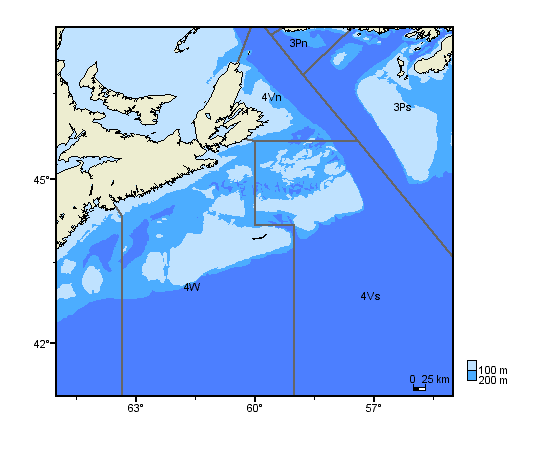
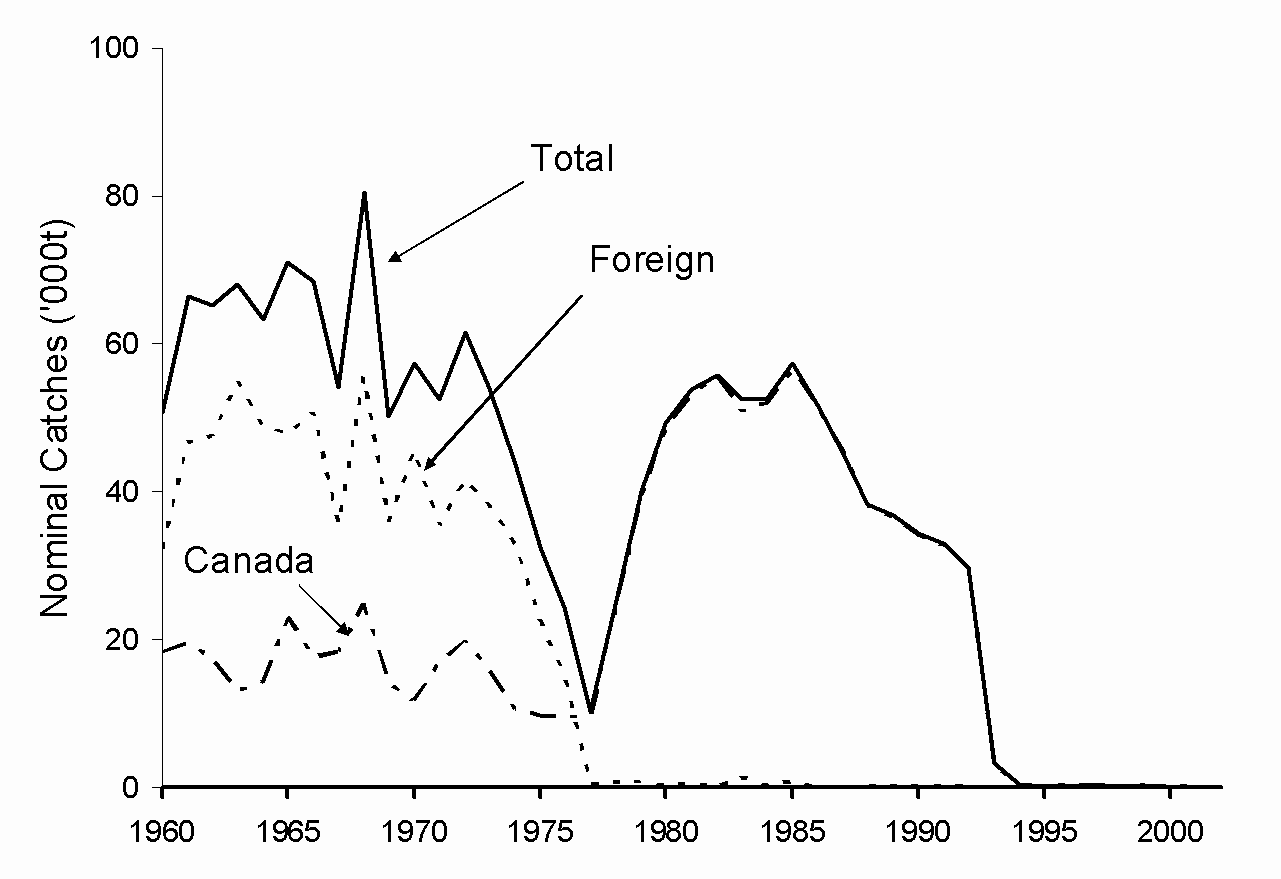
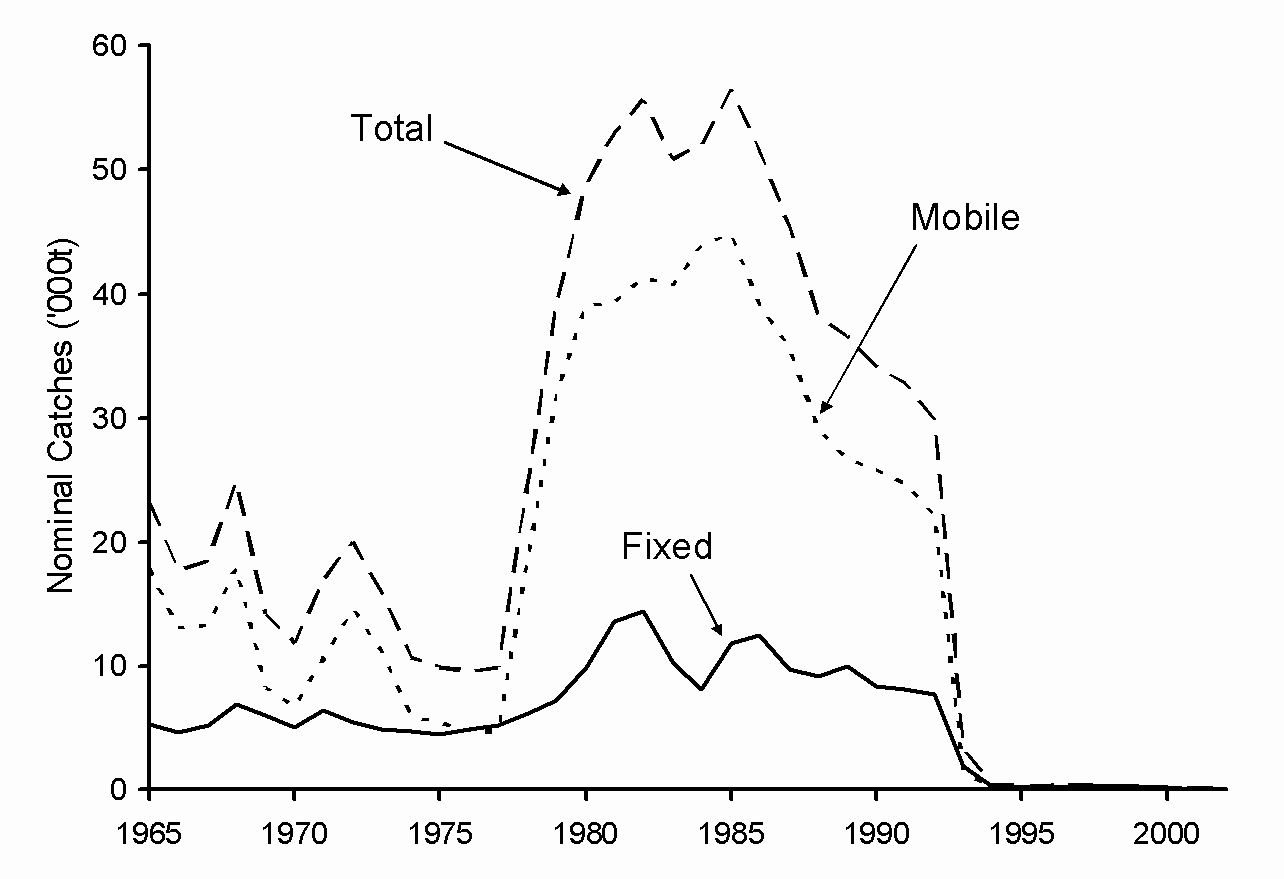
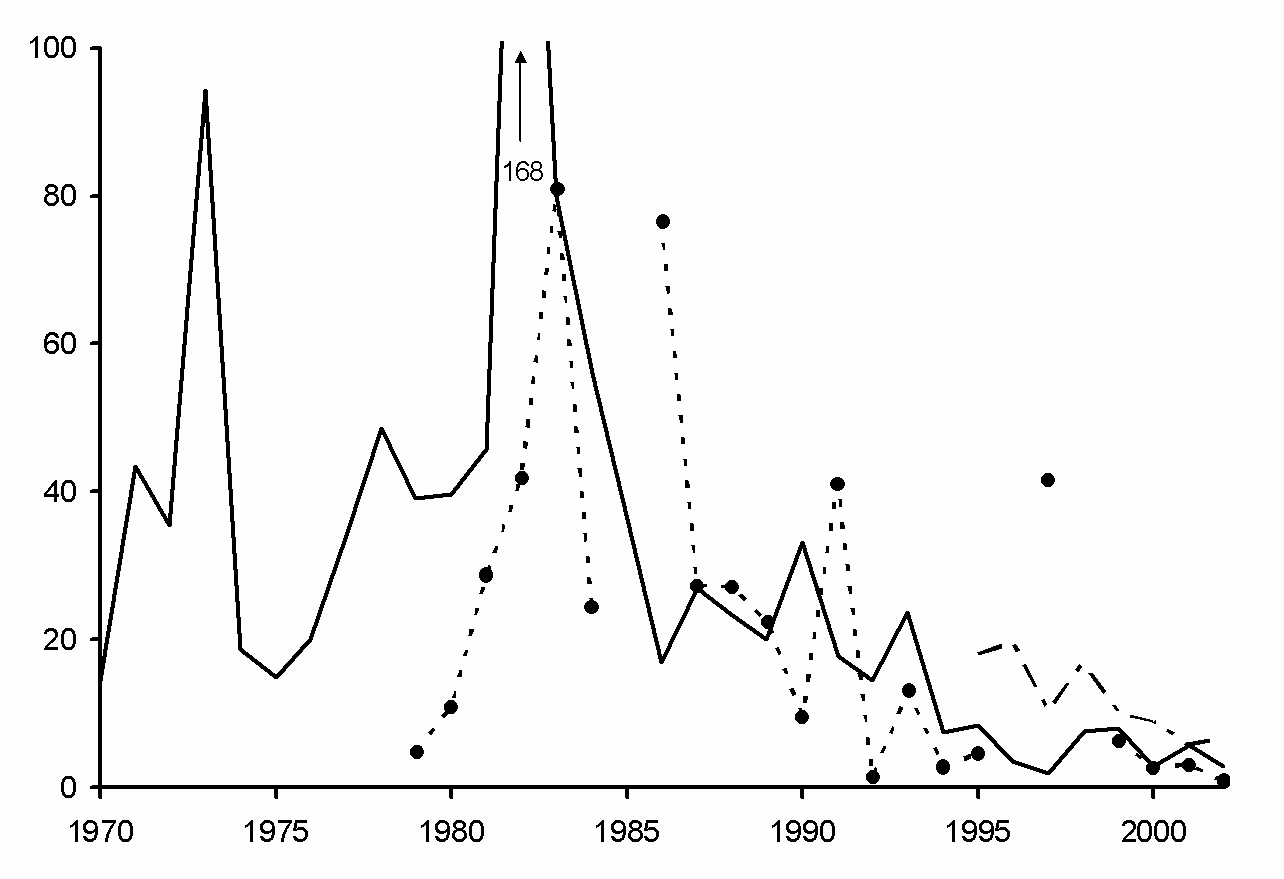
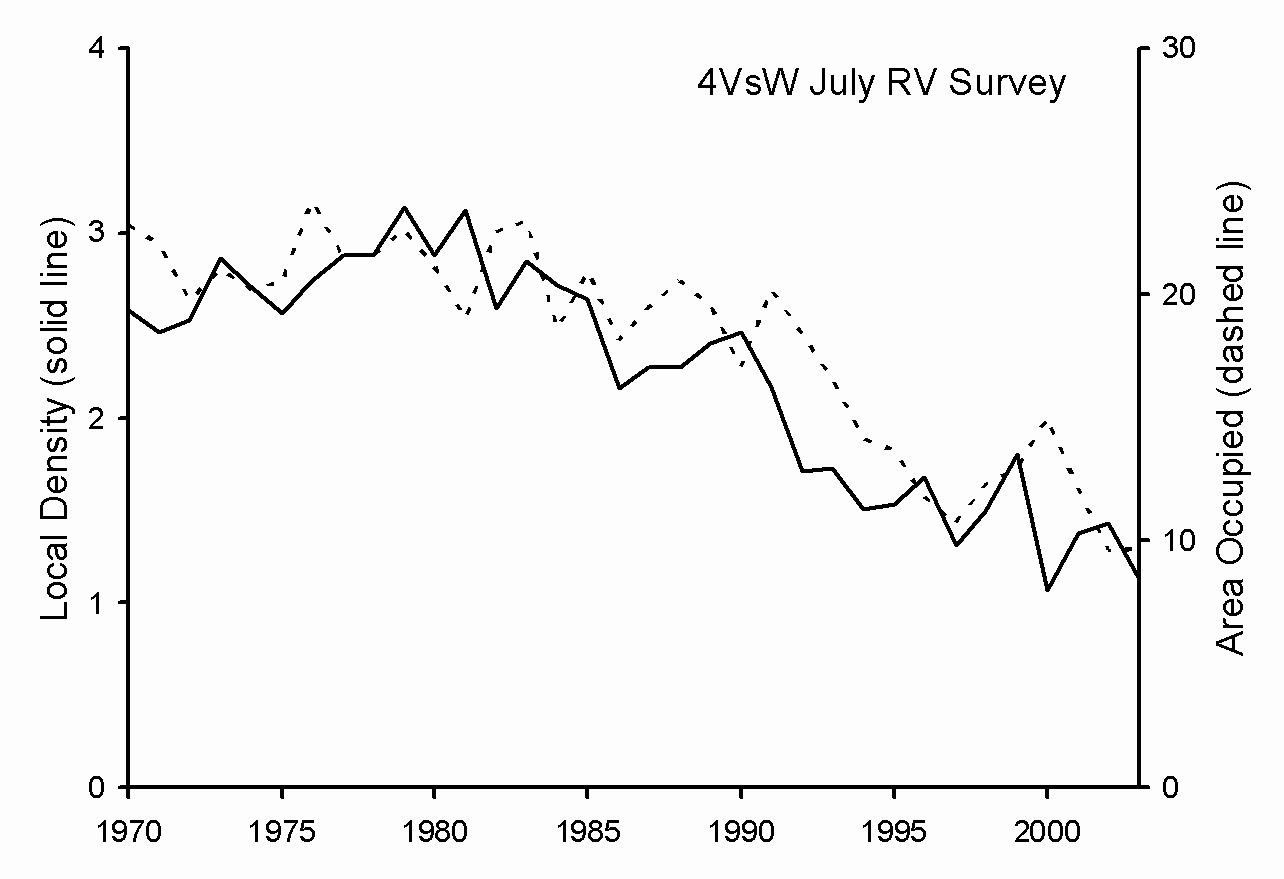

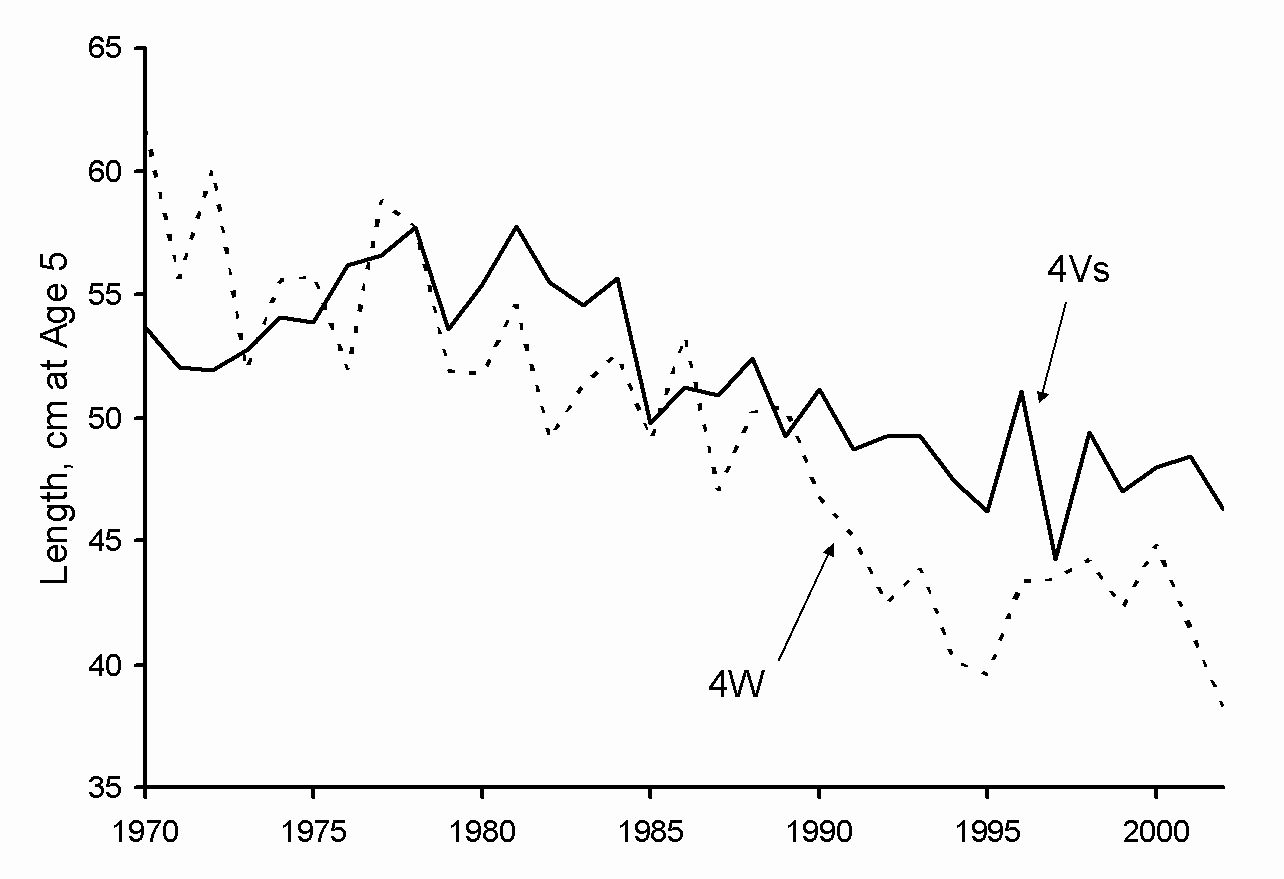

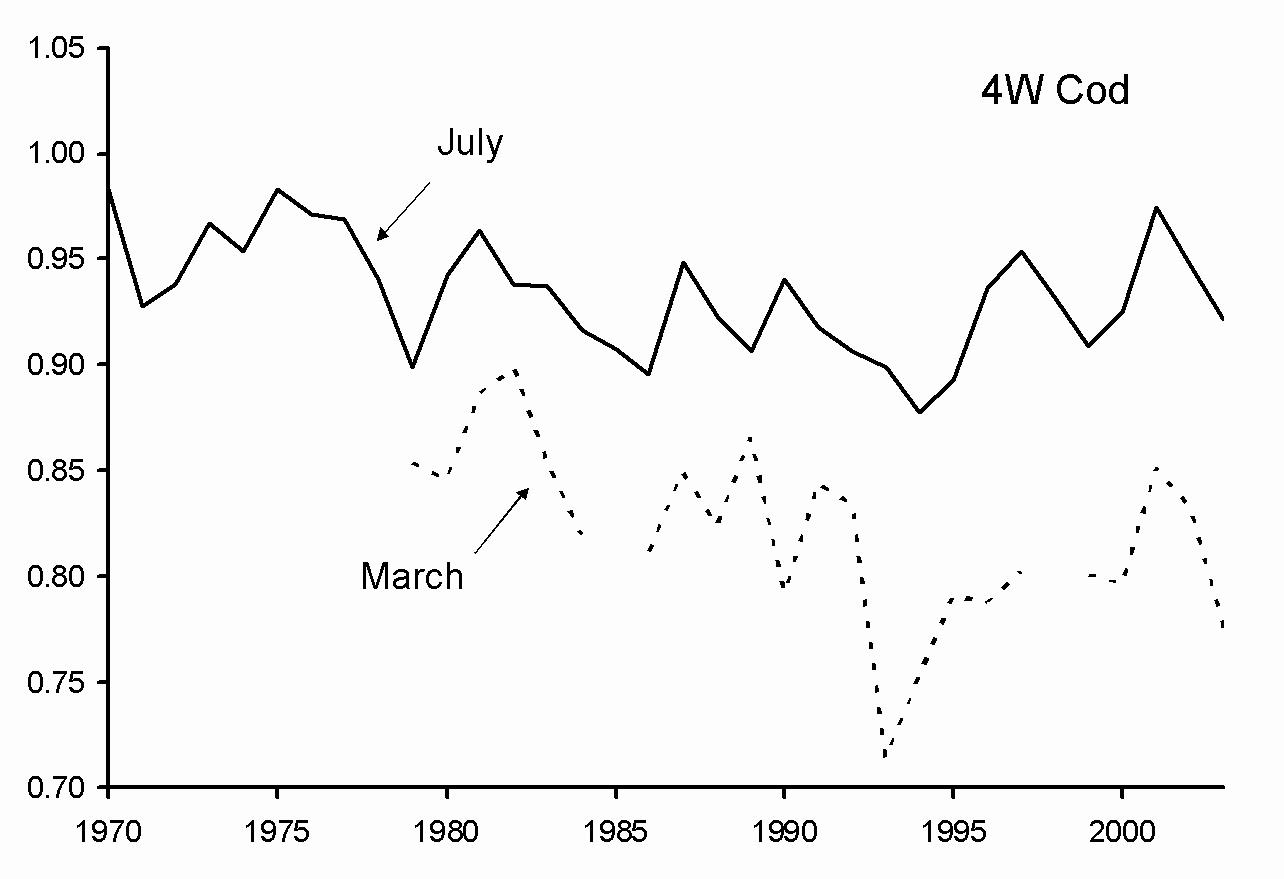


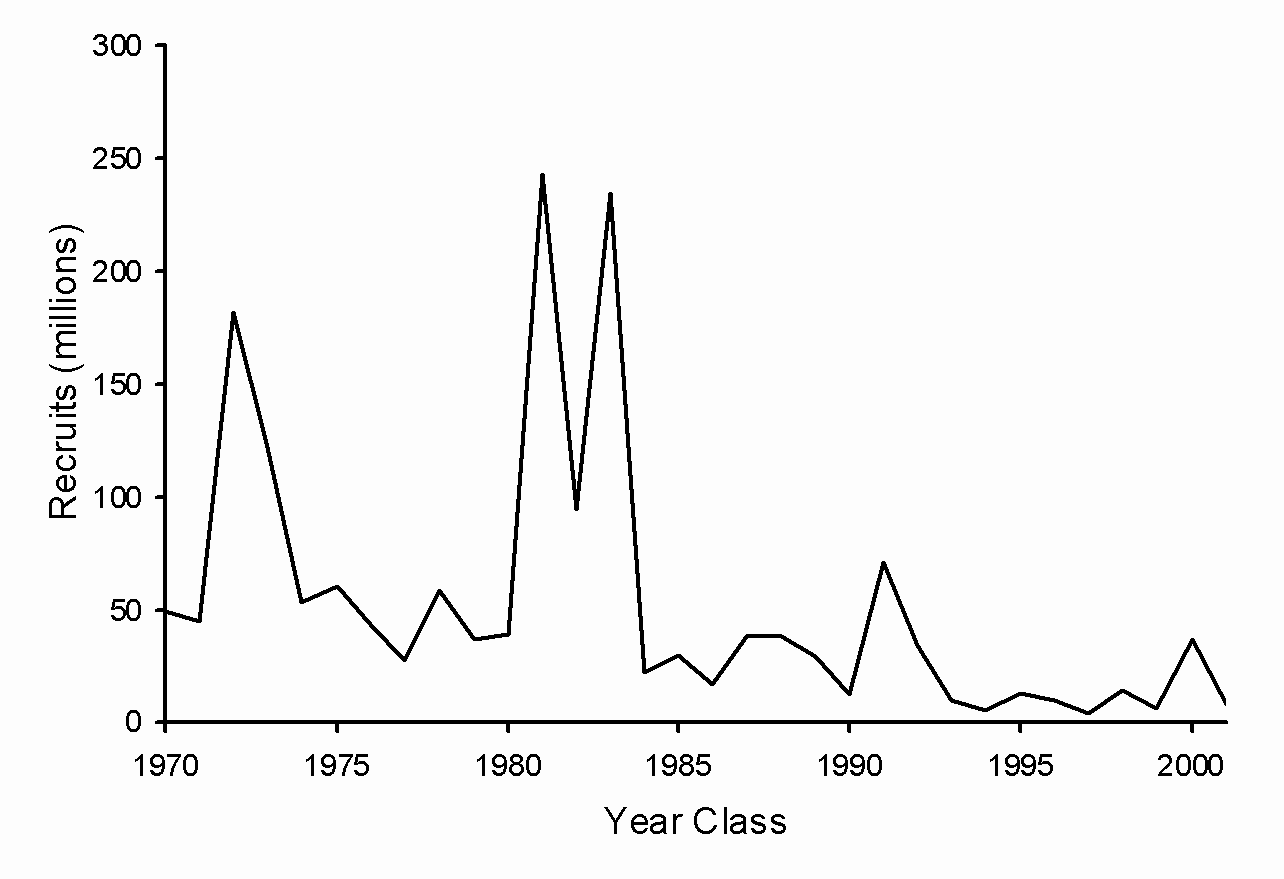

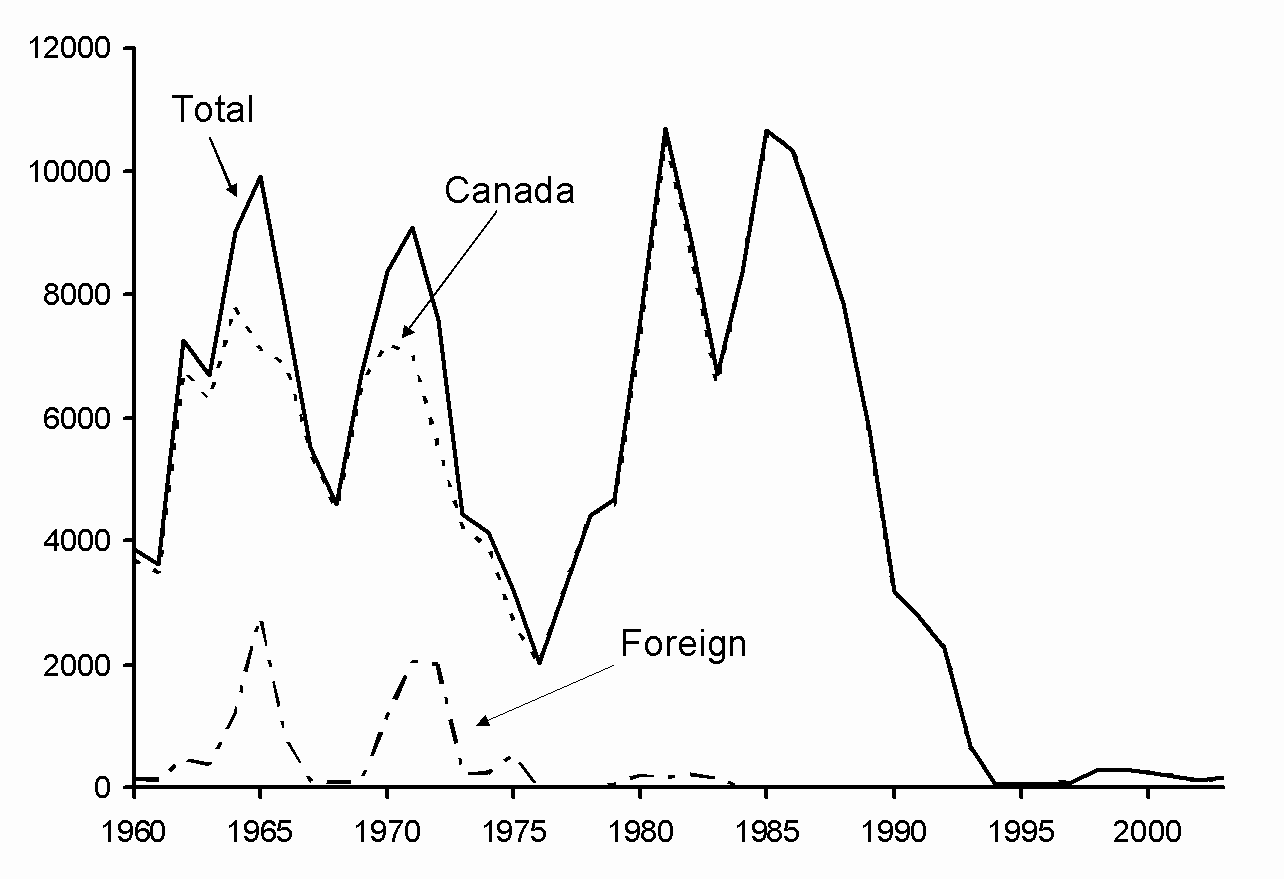
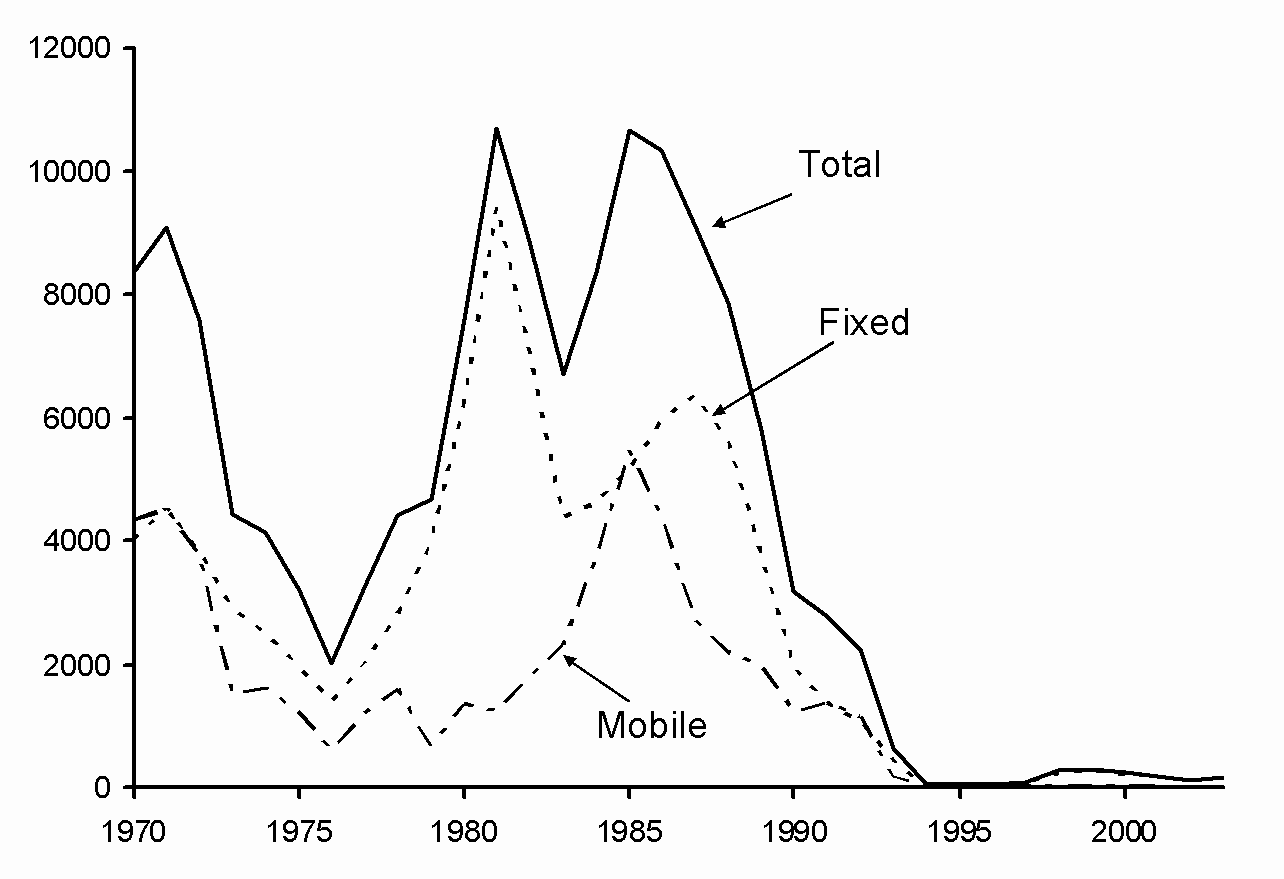

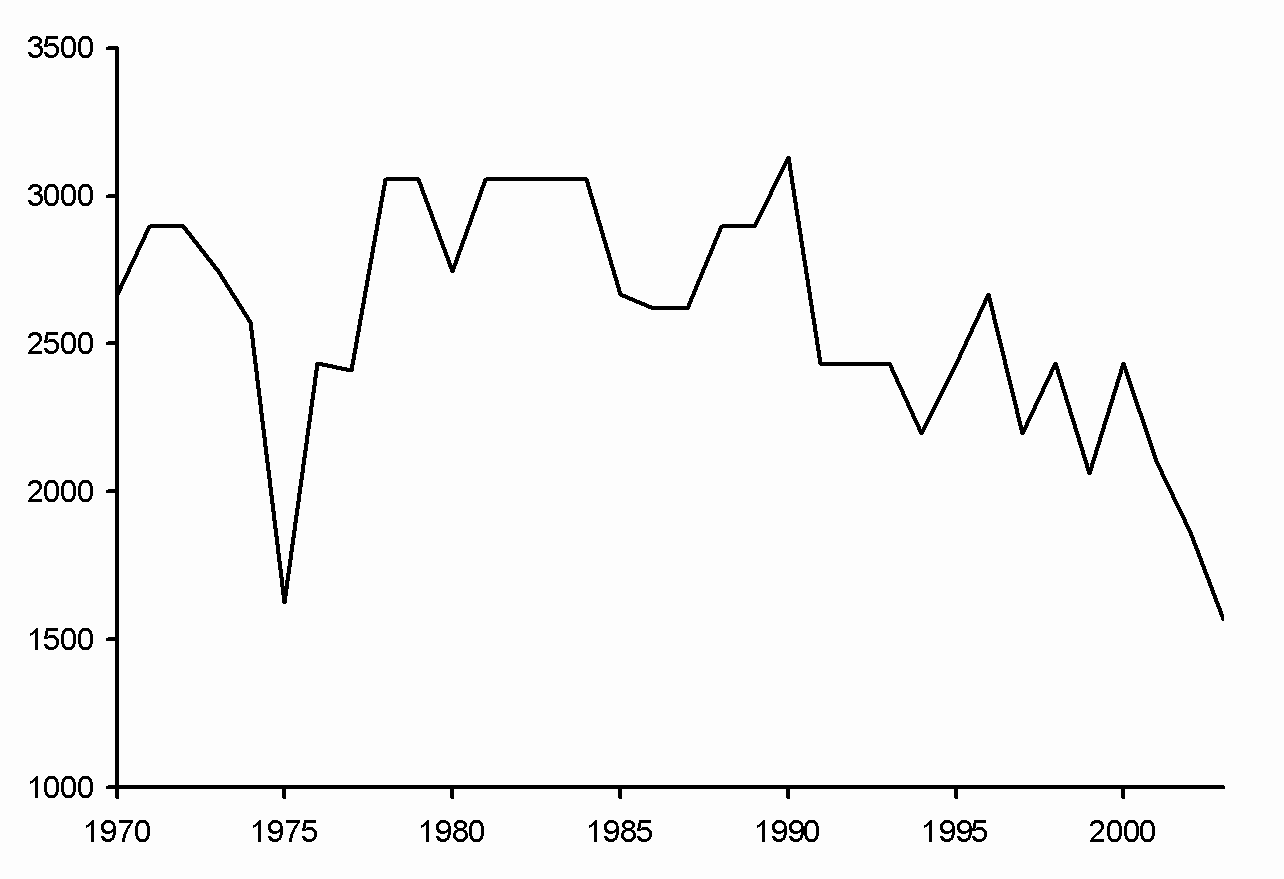
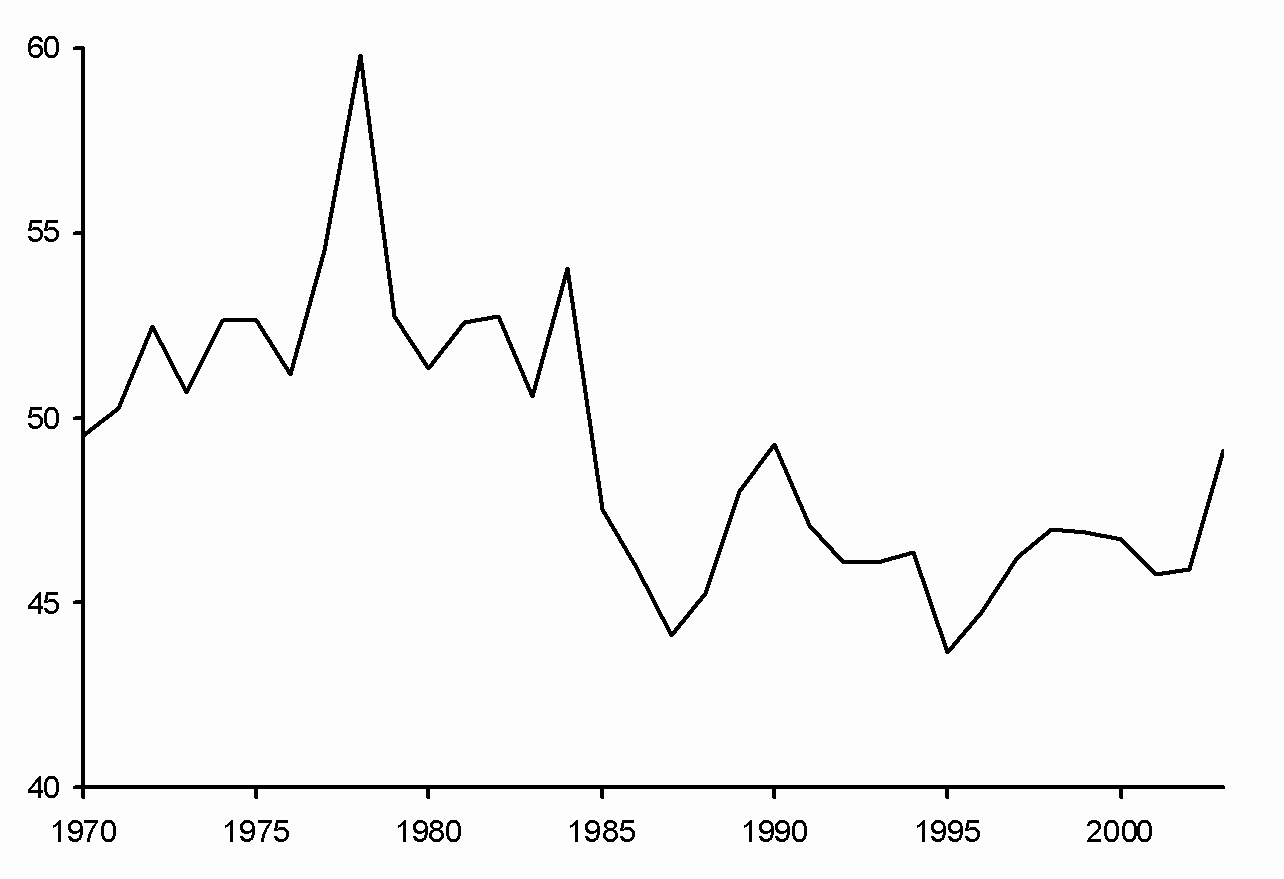

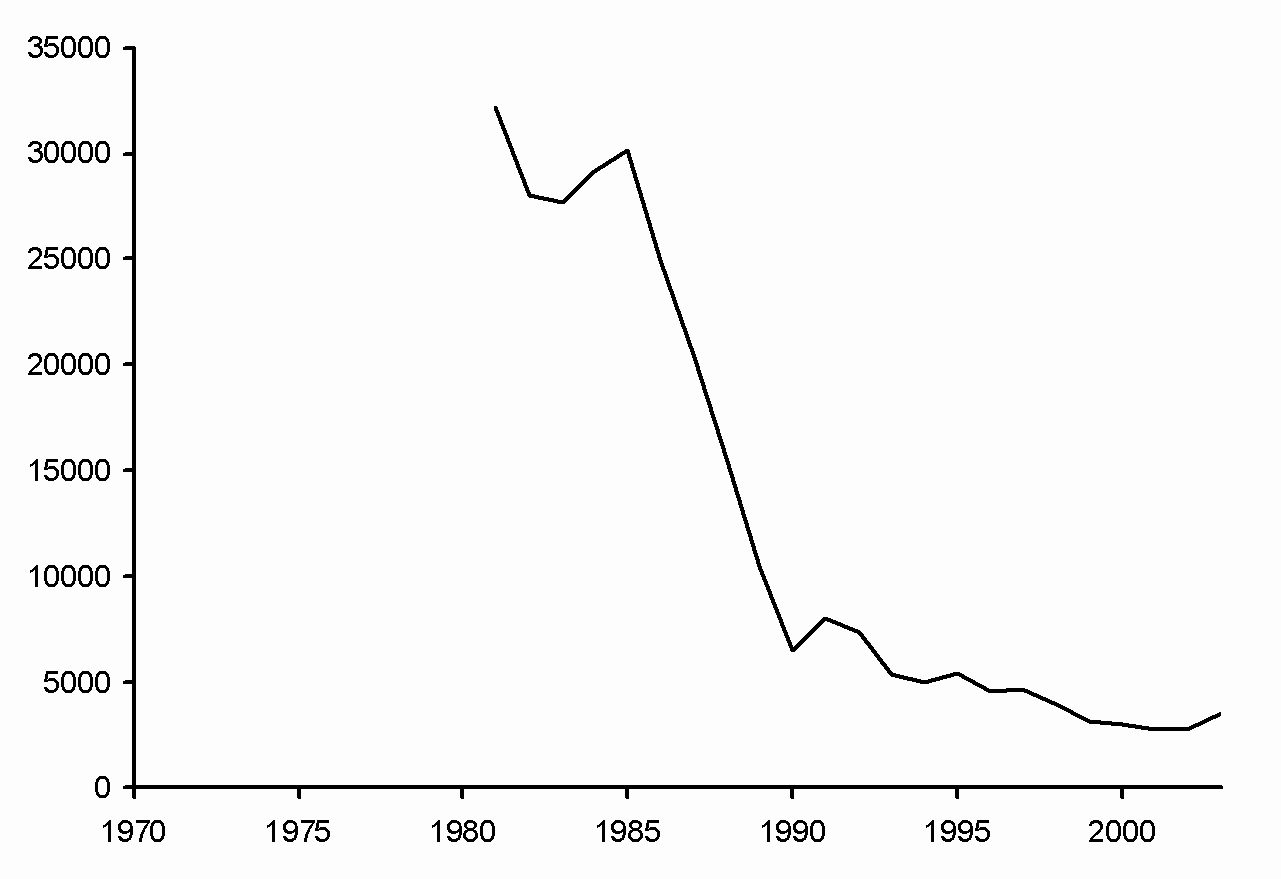
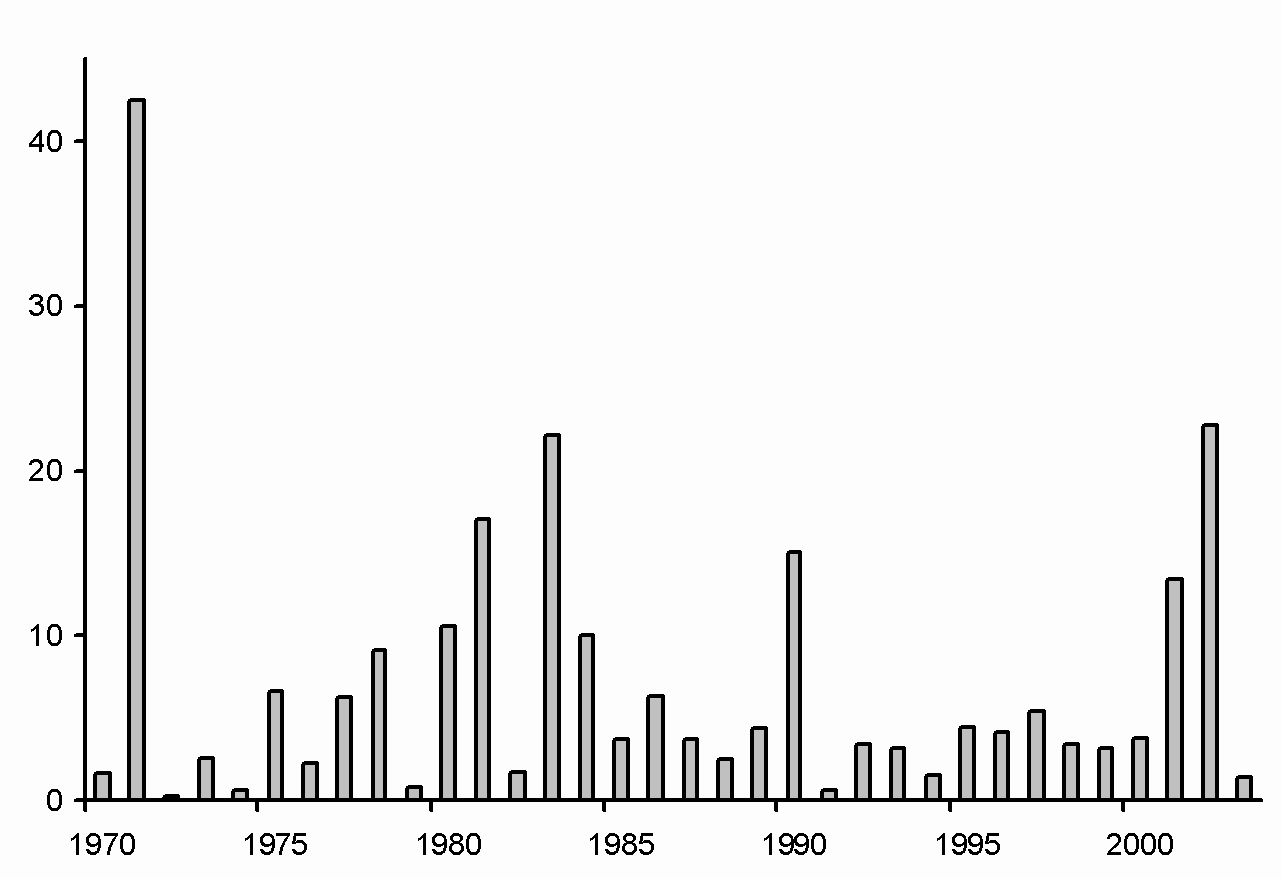

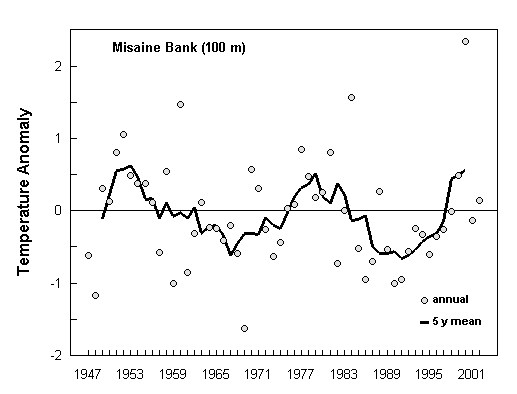
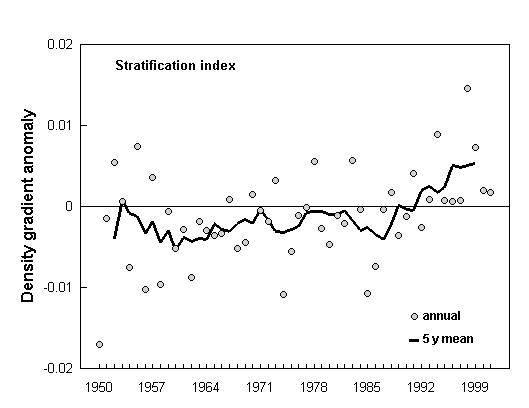
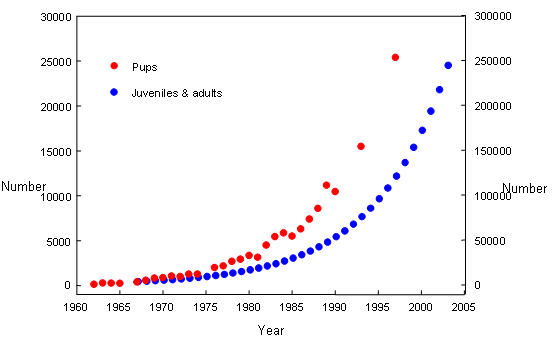
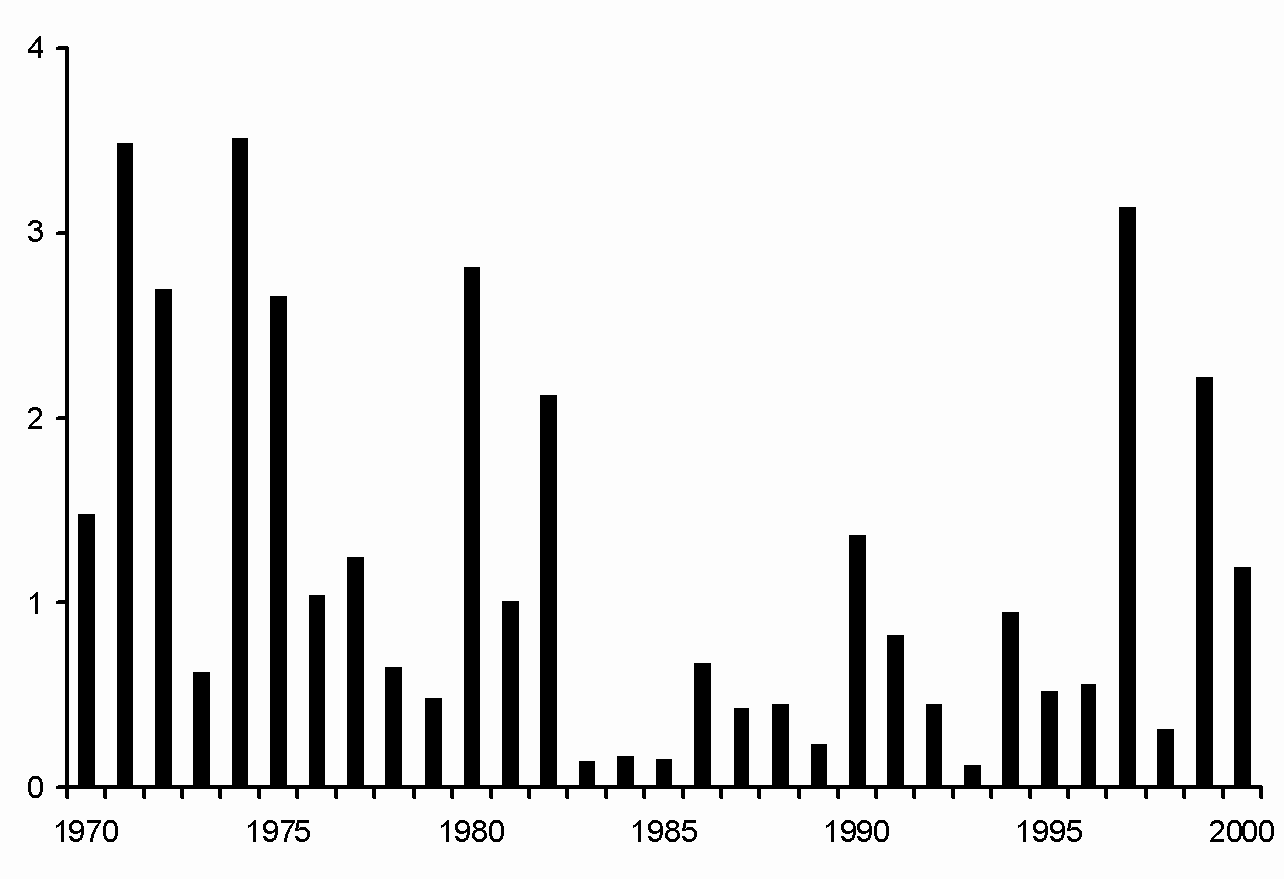
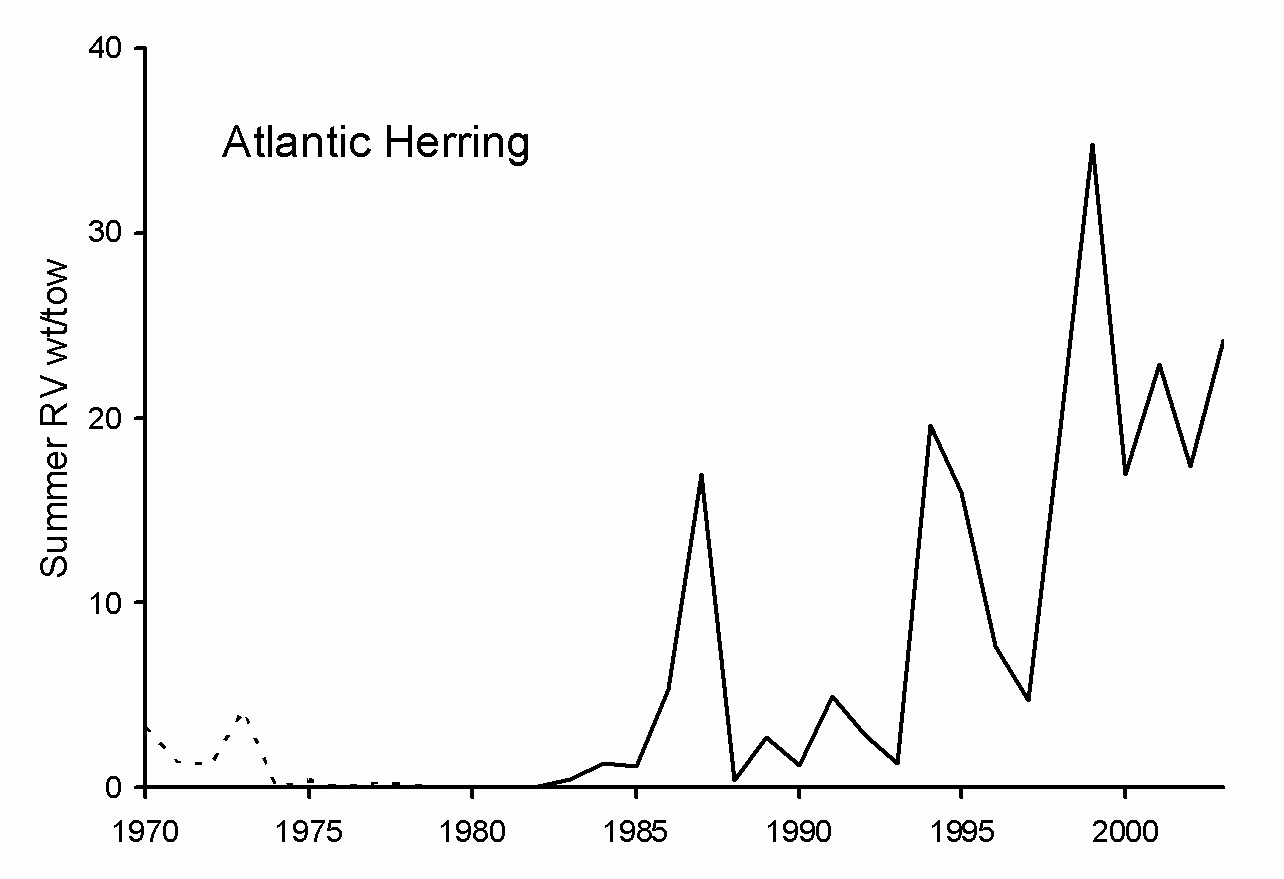
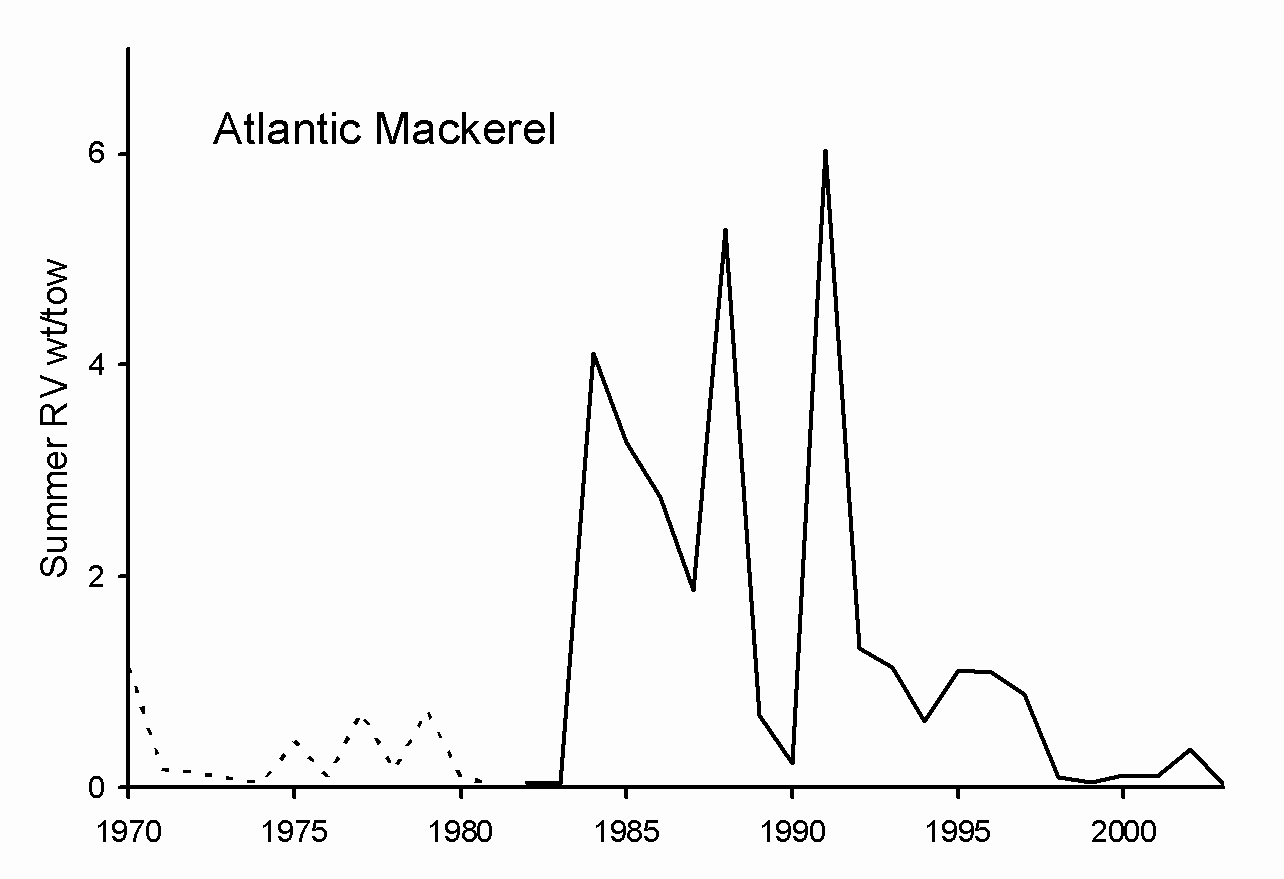
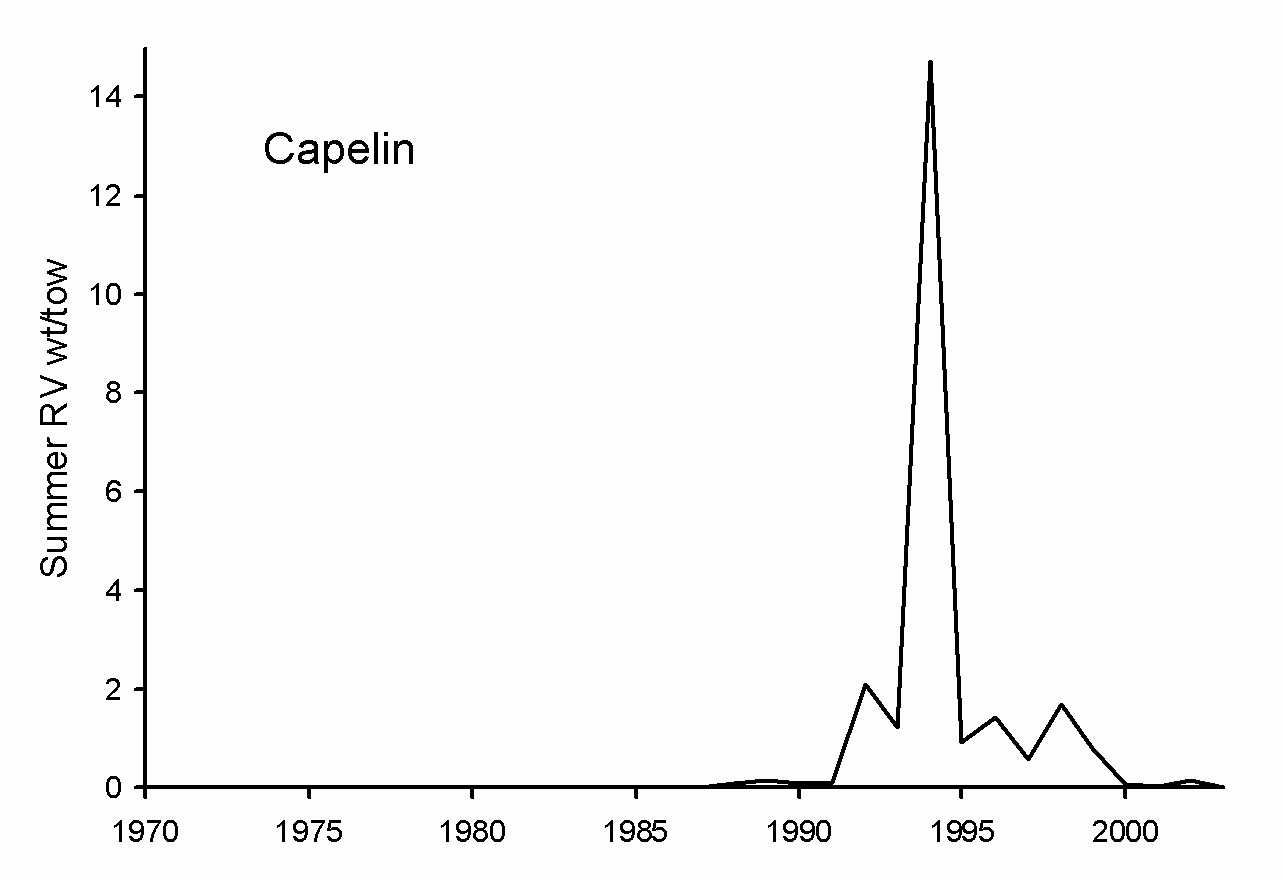
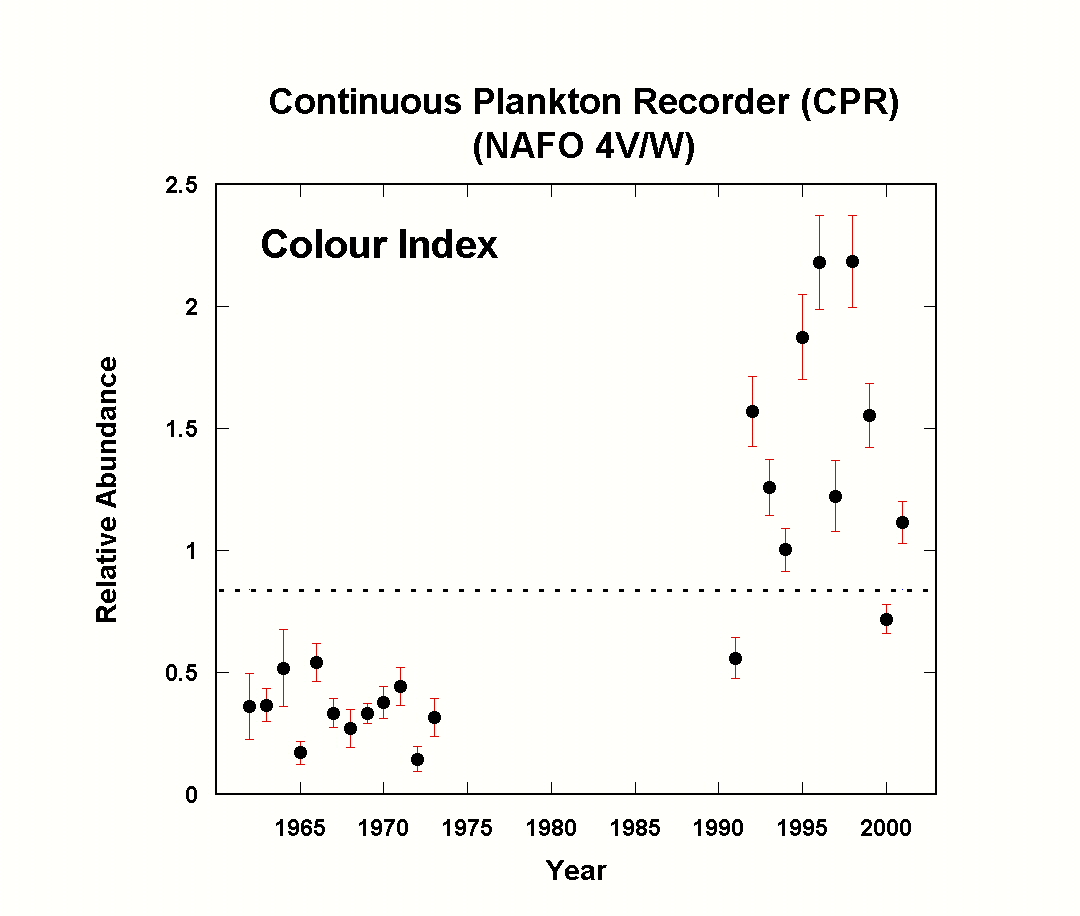

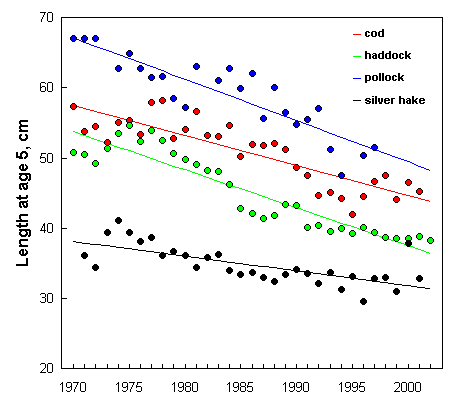
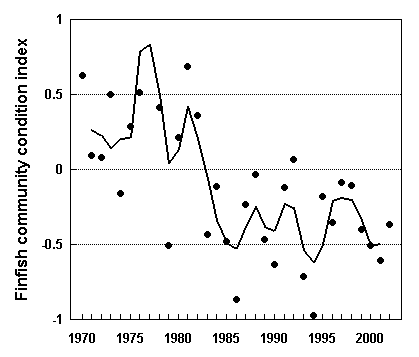
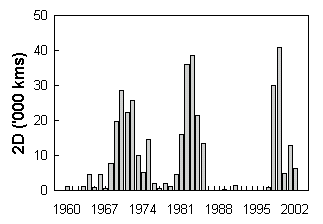
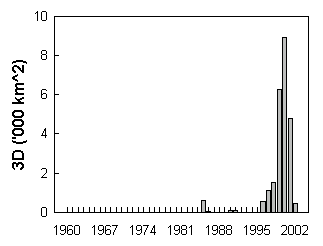

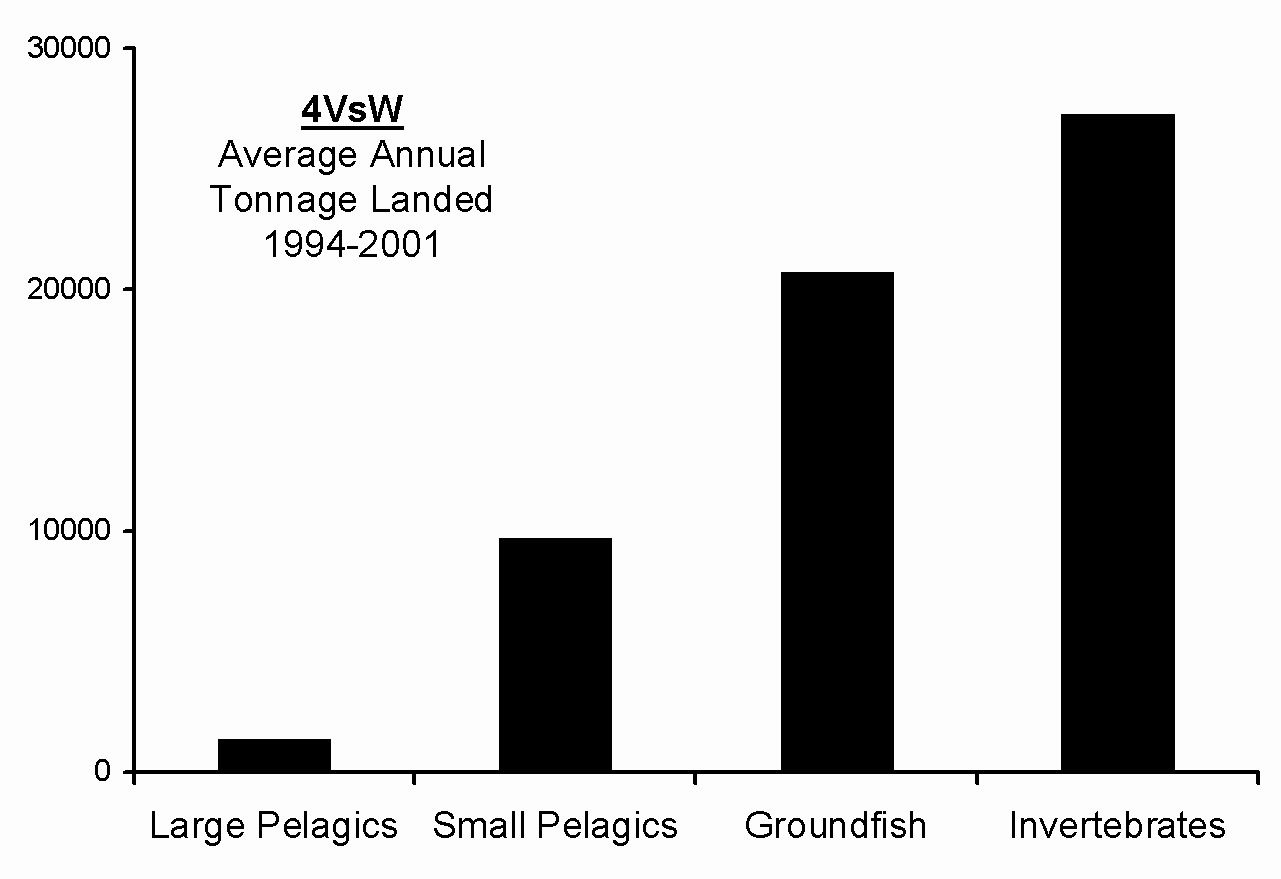
- Date modified: